FROM Luisenplatz, walking 300 metres along the Allee nach Sanssouci, I came to some gilded gates that guarded the park and its palaces. The gates bore the insignia of the Prussian king Frederick William IV, a monarch who enjoyed a mostly peaceful reign from 1840 to 1861.
Below one of Frederick William’s monograms, a modern health and safety sign warned that anyone who used the park was at “high risk” of falling branches. Duly notified, I pressed on.

There are no fewer than 17 palaces in Potsdam. Along with their associated parklands, and other palaces and palace-parks in Berlin and other centres nearby, they are run as a joint UNESCO World Heritage site by an organisation called the Stiftung Preussische Schlösser und Gärten Berlin-Brandenburg, meaning Prussian Palaces and Gardens Foundation Berlin-Brandenburg.
Founded in 1990 to take over assets that were mostly located in the former East Germany, the Foundation revived a version of the old Prussian royal eagle as its logo, though Prussia no longer exists as a state.
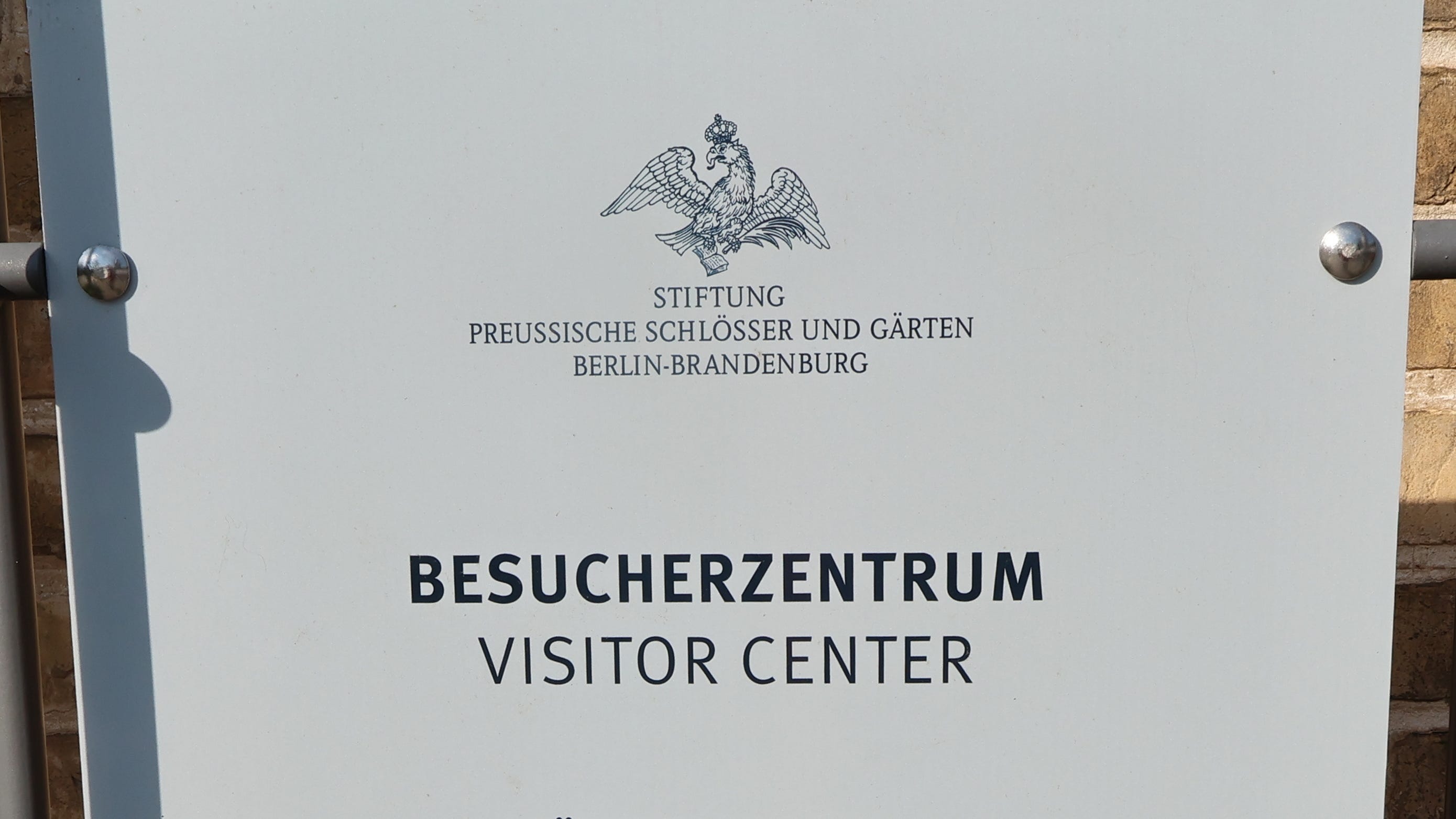
As with everything these days, you can get the app. There were also advertisements for things that were on in the palaces, such as a display of the paintings of the female ‘old master’ Artemisia Gentileschi.
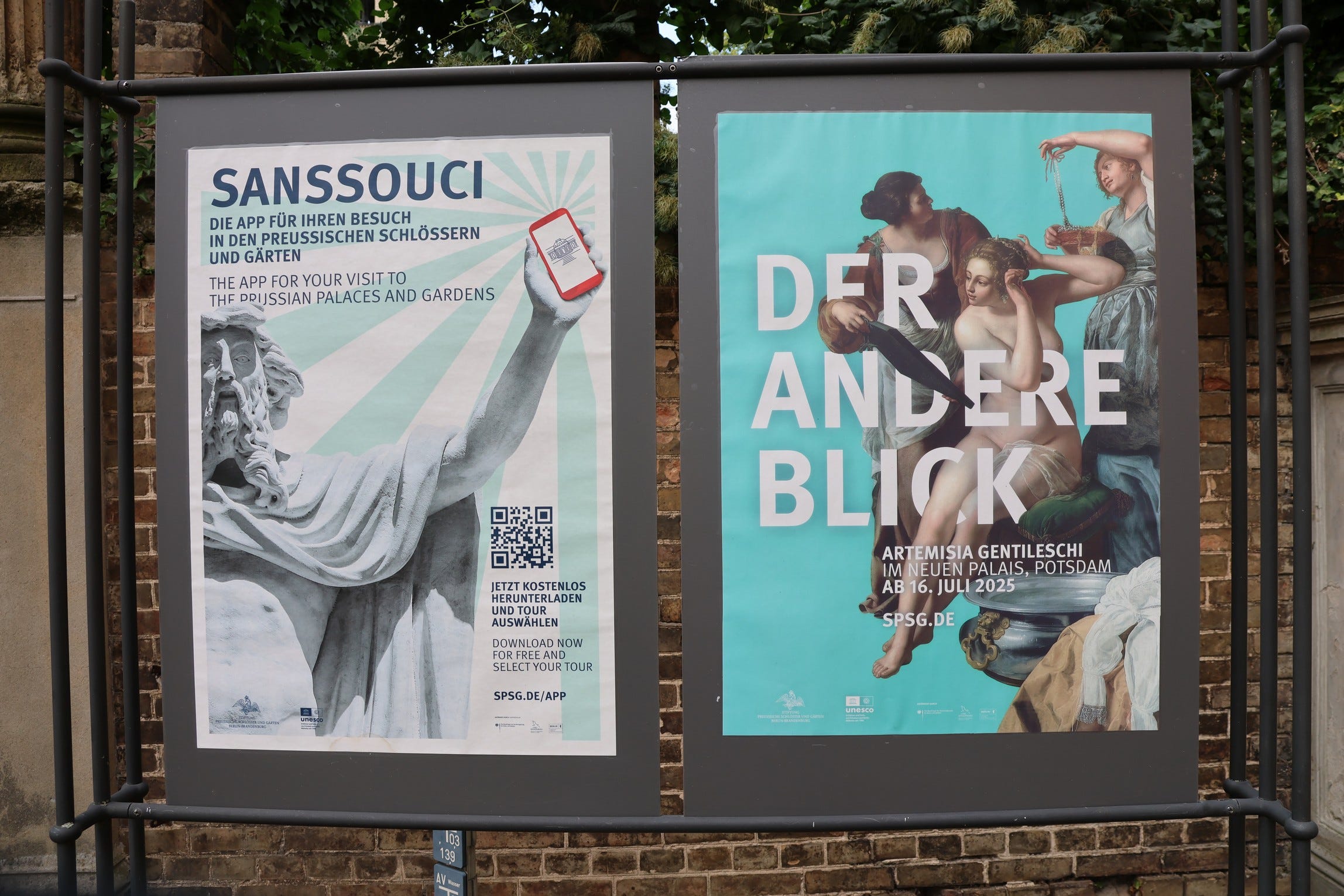
Gentileschi’s exhibition was called der andere Blick, ‘the other view,’ held im Neuen Palais, ‘in the New Palace.’ Of course, anything referred to as ‘new’ in Britain or Europe is generally at least two hundred years old, and the New Palace definitely falls into that category, as it was built for Frederick II in the 1760s. I suppose it was new then.
Other posters advertised an art exhibition on the grass (‘Kunstwiese’) and boat trips to Pfaueninsel (‘peacock island’): another royal retreat, which used to be overrun with peacocks and other elements of a menagerie before becoming part of West Berlin in Cold War days, while the rest of Potsdam wound up in East Germany. Perhaps that is what the words so fern und doch so nah, ‘so far and yet so near,’ refer to.
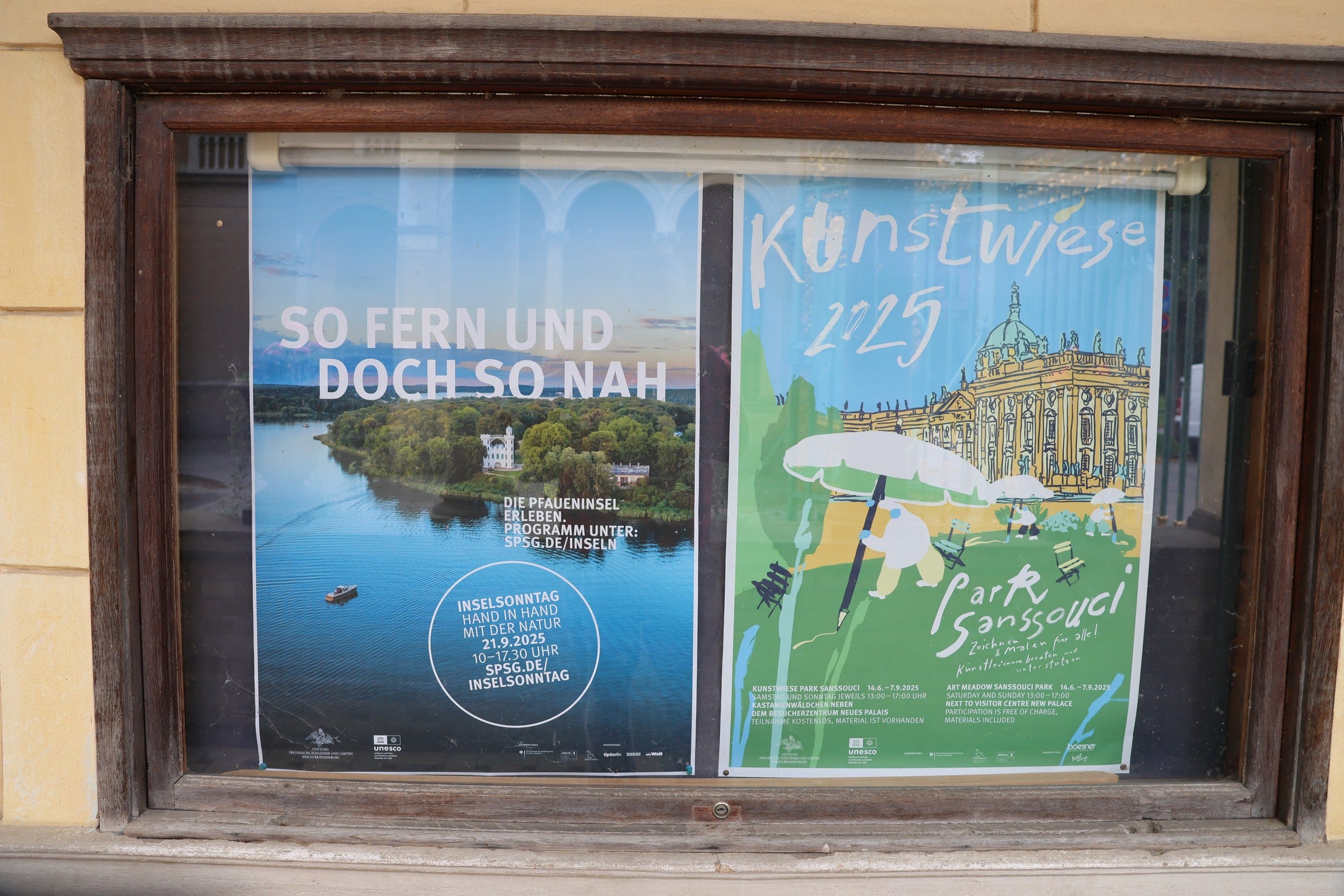
Upon the gate leading into Park Sanssouci, the Foundation had posted an amazingly long list of rules called the Parkordnung, to which a sticker forbidding drones had lately been added for good measure.
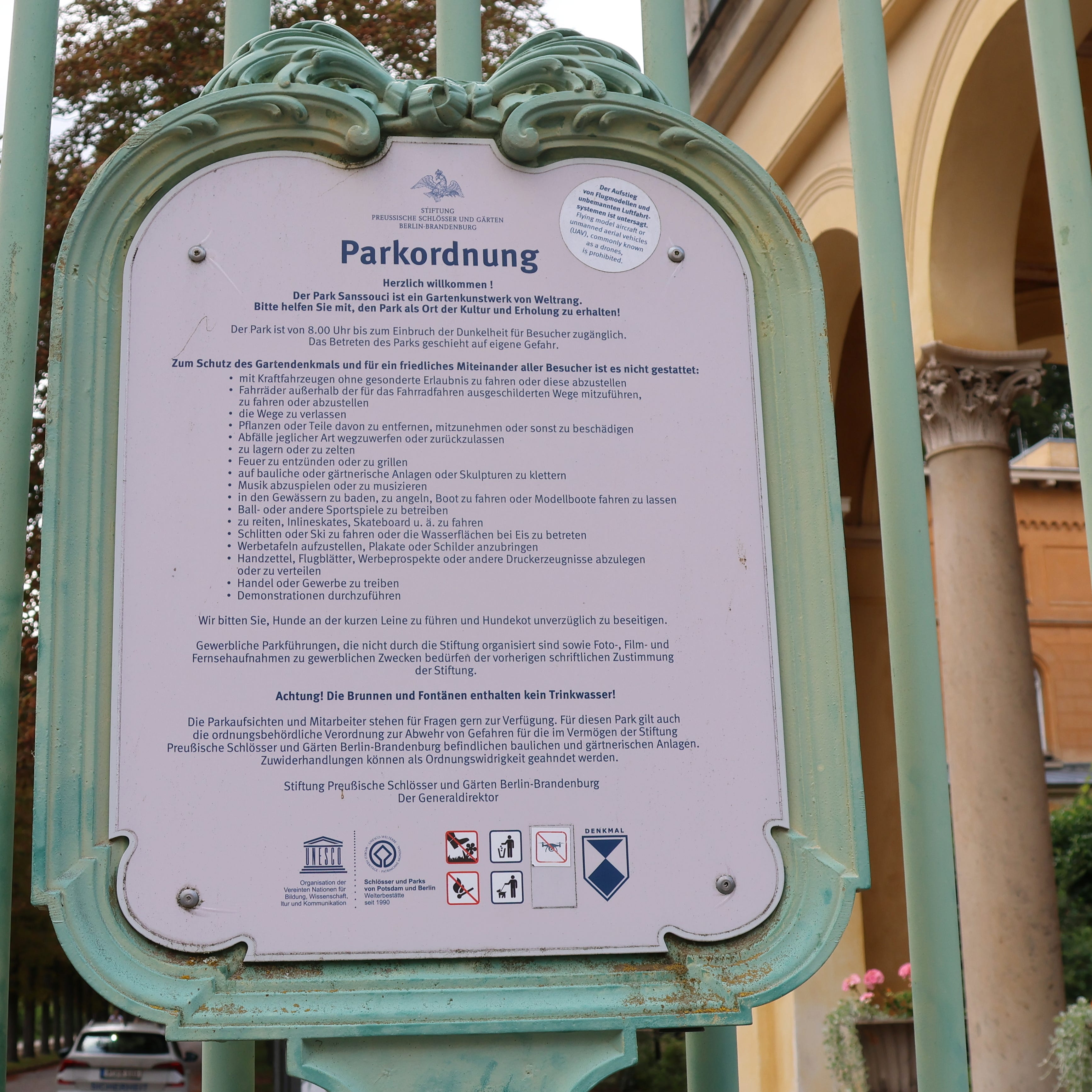
The Parkordnung, which you see everywhere, seems like a stereotypical instance of German, or Prussian, officiousness.
But then again, most of the rules are commonsense — e.g., not lighting fires, not pulling up the plants and taking them home — and probably empower the park police to confront any hooligan with the words “haven’t you read the rules?.” A bit like an EULA, in other words.
The gate was next to a church called the Friedenskirche (Peace Church), built in the Italian style during the 1840–1861 reign of Frederick William IV, with a campanile in place of the steeple.
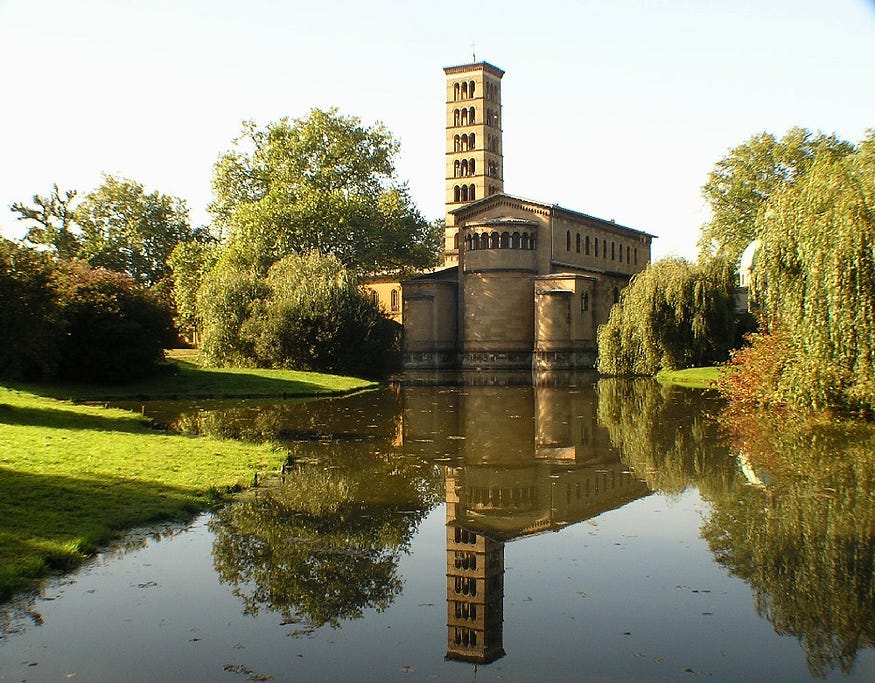
Beyond, there was a beautiful straight avenue, lined with trees. Apparently, in the old days, all Prussian roads were like this, ensuring plenty of shade for weary travellers.
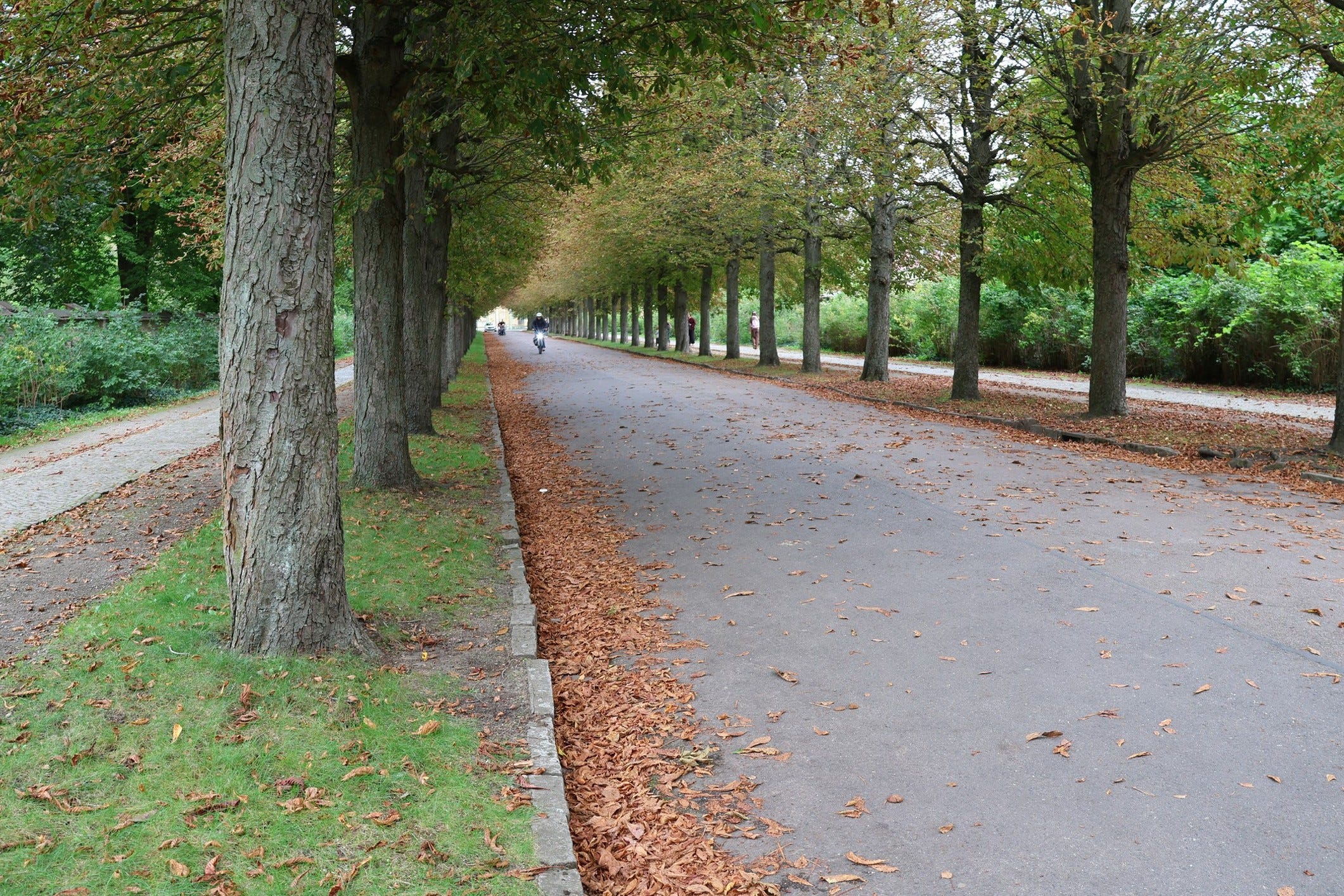
Perhaps this leafiness accounts for the sign that said visitors were at high risk of falling branches, though the alternative of being fried in the sun is surely worse.
Another sign saying Schmeisst es weg! — a more vigorous expression than ‘throw it away!,’ more like ‘smite it away!’— encouraged everyone to hurl their change, their Spende, into the slots provided for the park.

The car on the left is park police, the word Sicherheit meaning ‘security.’
It wasn’t long, strolling along this road in the vast park, before I caught a glimpse of the Sanssouci Palace, after which the whole park is named.
In the next photo, you can see a fountain called the French Rondel, plus successive flights of steps leading up to the Sanssouci Palace, the palace at top, as well as terraces on each side of the steps. And whimsical sculptures made by French artists in the employment of the Prussian king Frederick II, around the year 1750.
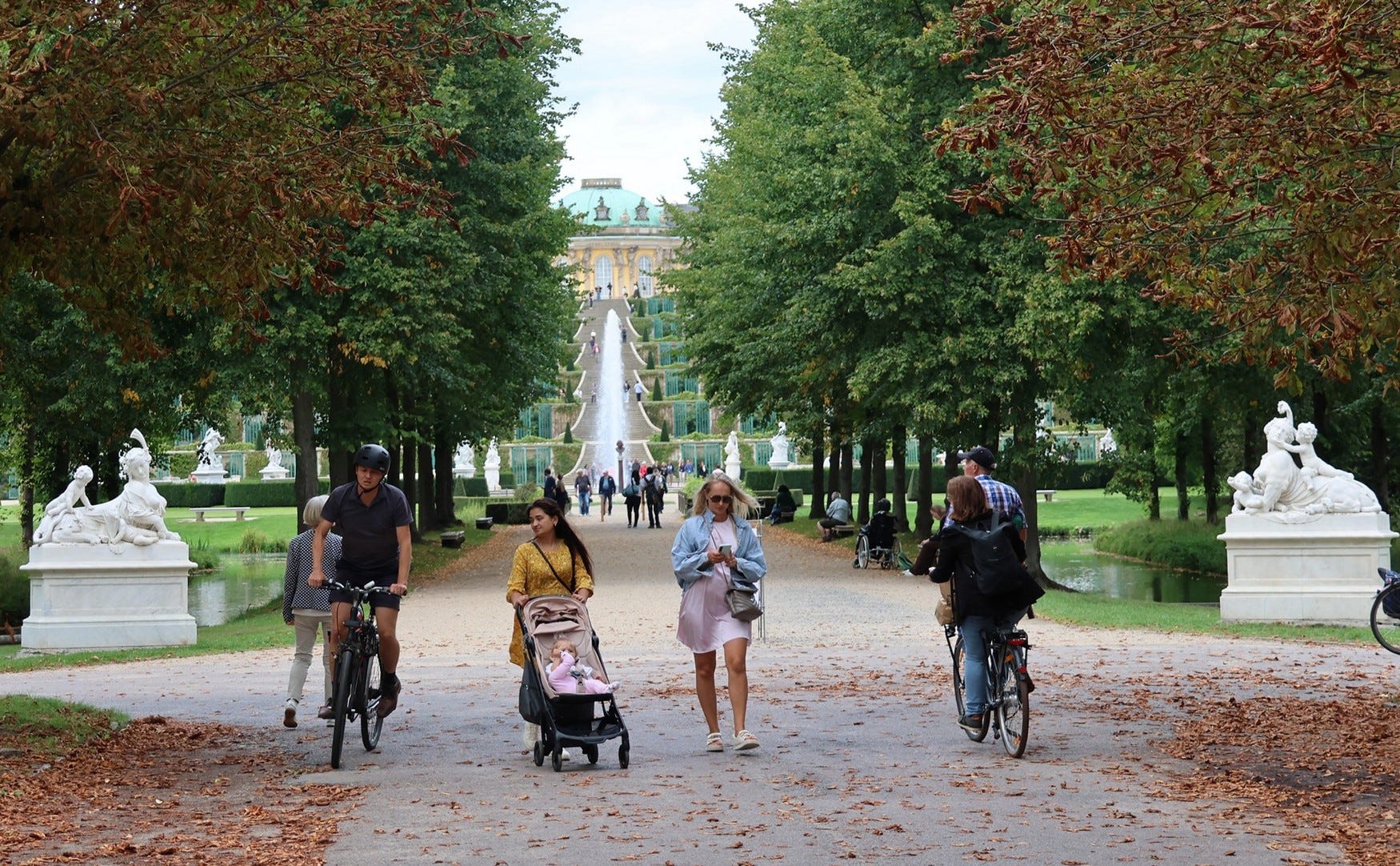
Here’s another view from a bit further along, past the fountain. Sans Souci means ‘without care’ or ‘carefree’ in French, the preferred language of the Prussian court and many other European courts in those pre-revolutionary days. Basically, this whole area was Frederick II’s Versailles.
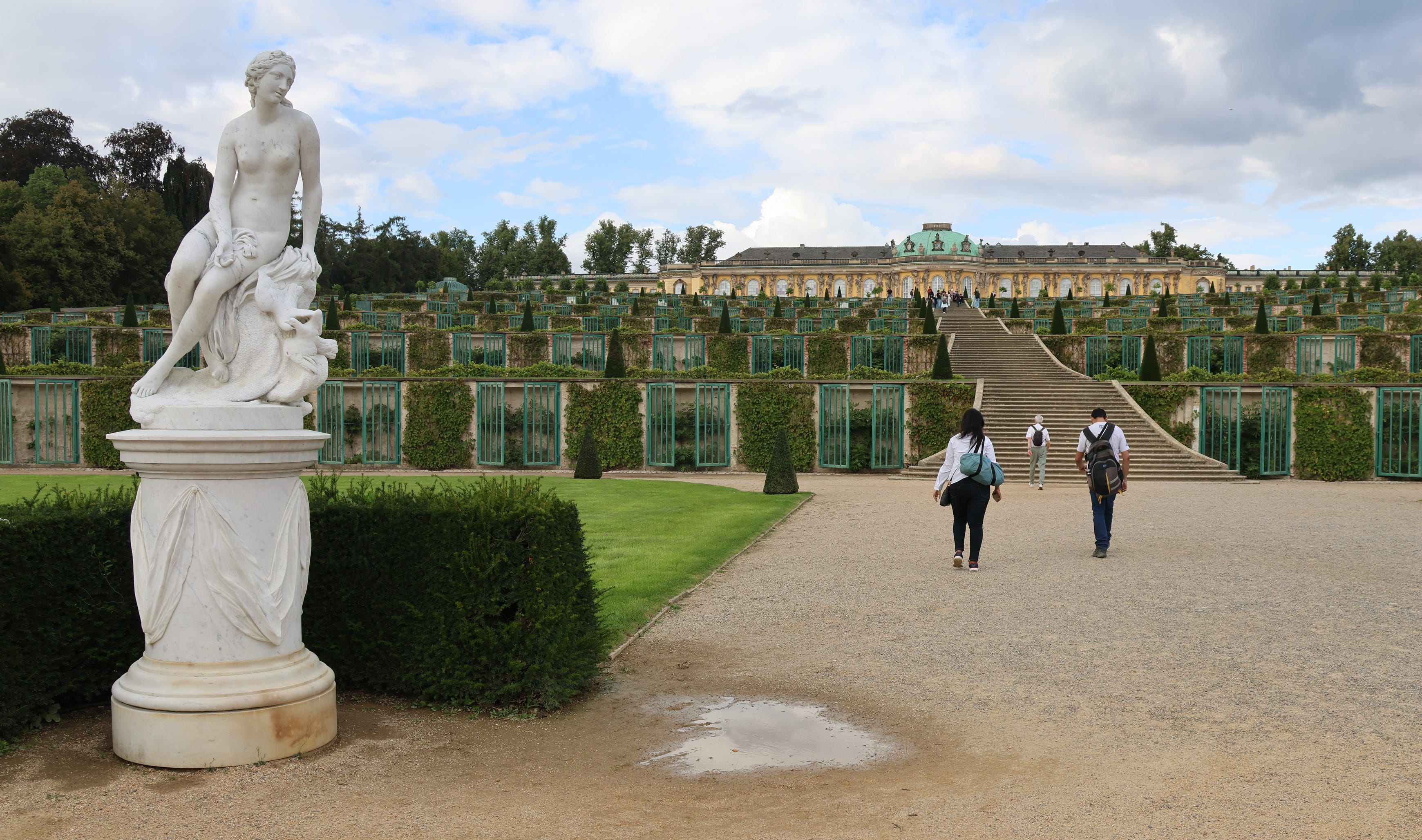
On each side of the steps, you can see the terraces I mentioned, which face south and have periodic recesses with gates that have glass in them, if I recall correctly.
Though Potsdam has a northerly latitude and suffers harsh eastern European winters, which were even worse in Frederick’s day, these terraces enabled him to grow grapes.
The French Rondel is surrounded by statues on classical themes, most of which are exceptionally lively and playful!

Heading on up the steps, you come to Sanssouci Palace itself, distinguished by a curious comma between the words Sans and Souci, which is why Potsdam is known as the town of Sans, Souci.

On each end of the palace, there were trellis arbours, both long and short, that must have supported more vines of various sorts in the old days.

This fascination with vines and plants led to a style of decoration known as Frederician Rococo, which was both naturally-coloured and gilded.
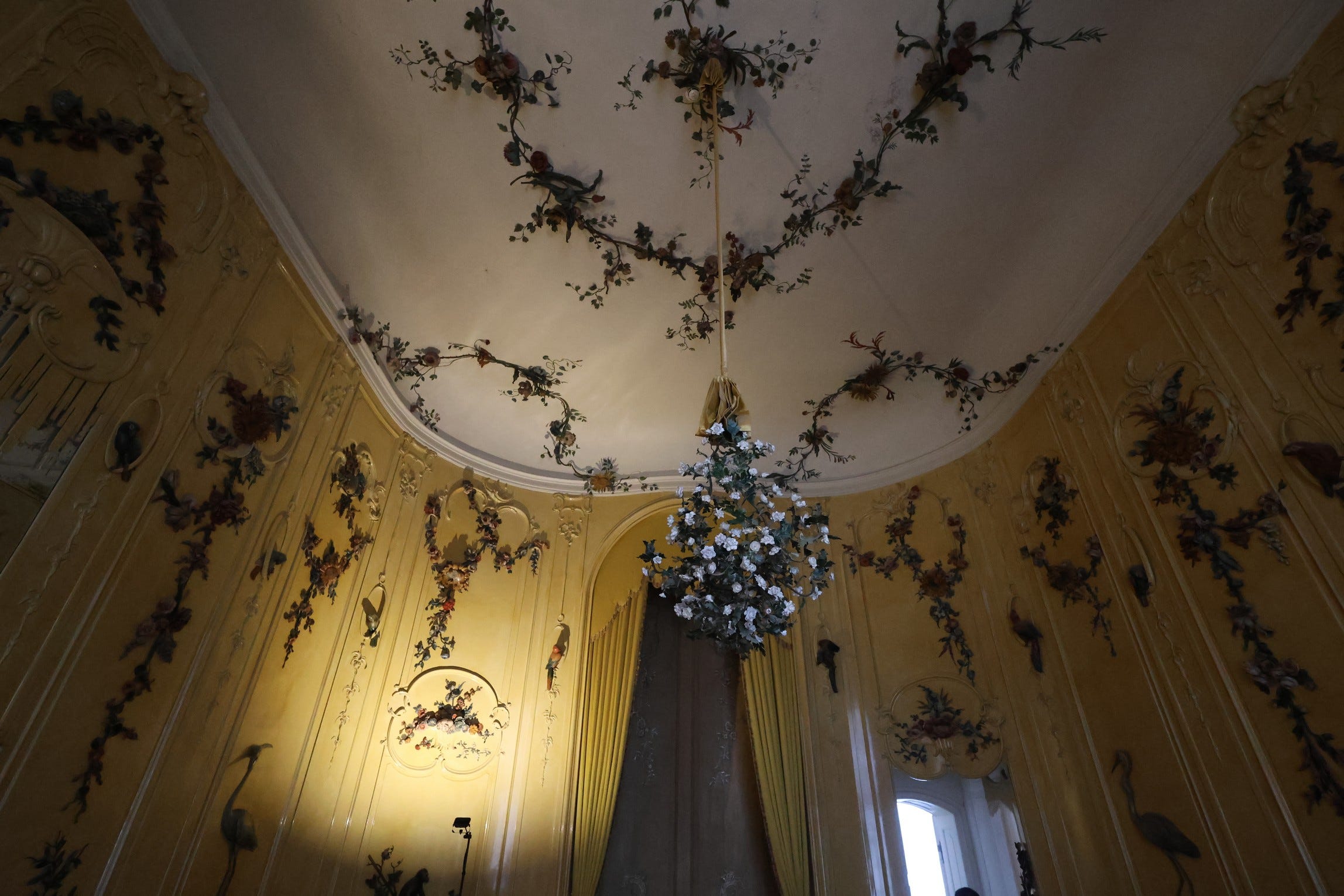
In another room of the palace, Frederick’s hall of mirrors, you could see similar patterns in gilded Frederician rococo.

Here’s another photo from the hall of mirrors.

In the palace, you got given little audio devices that explained the significance of each of the successive rooms. I started in the front and then went down a remarkable hallway lined with decorative sofas that were too narrow to sit upon.
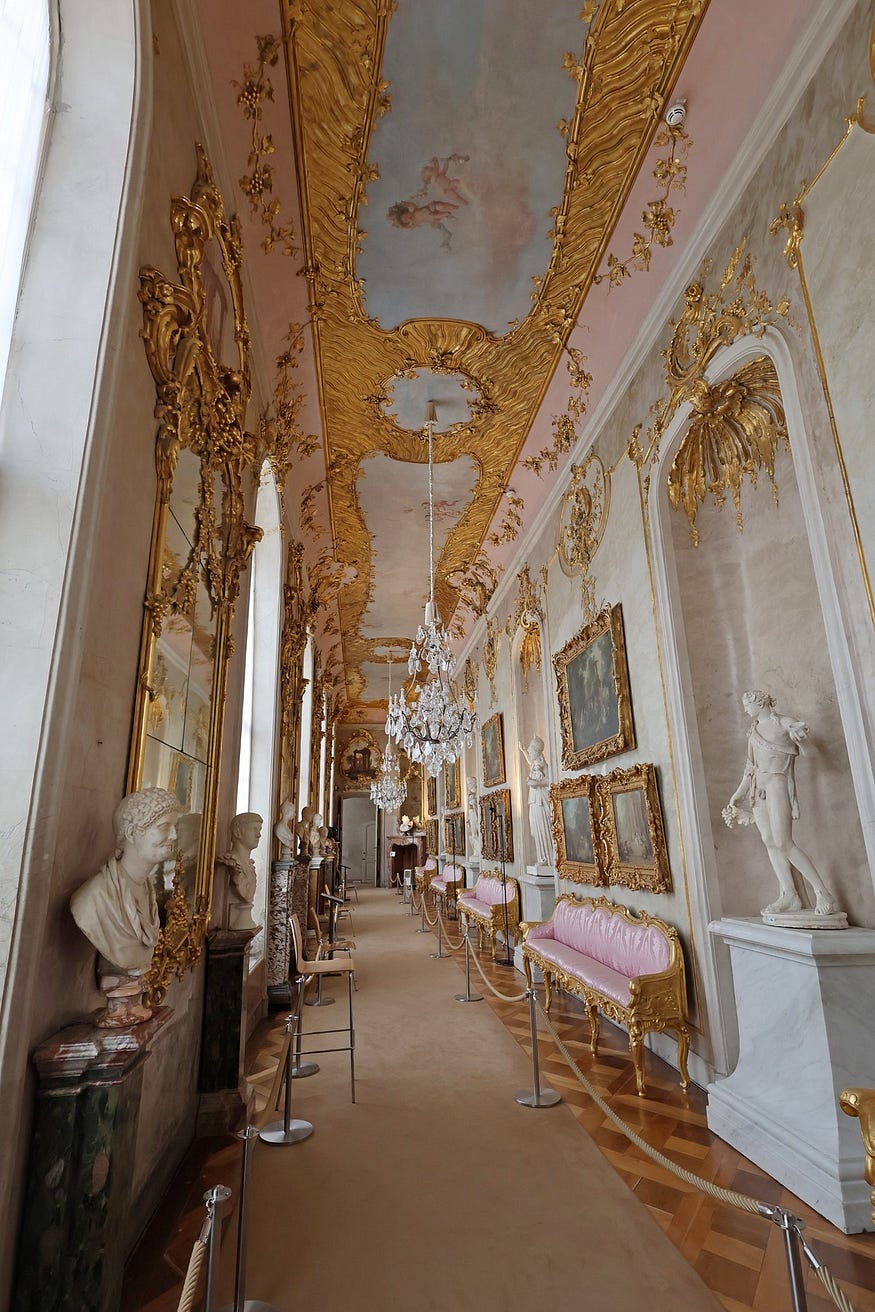
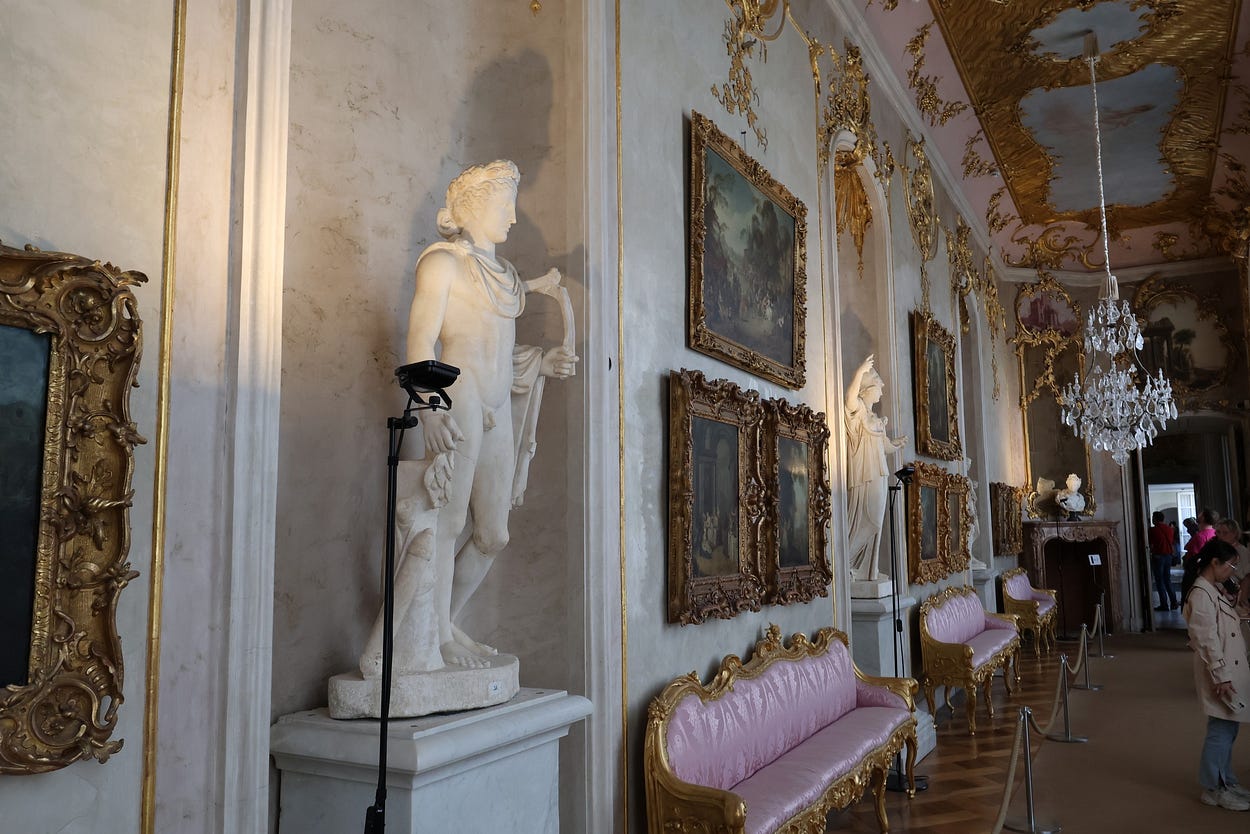
I peered inside Frederick’s library. He was quite a studious man, with a huge collection of books, many of them duplicated in different palaces so that he wouldn’t have to take them on journeys.
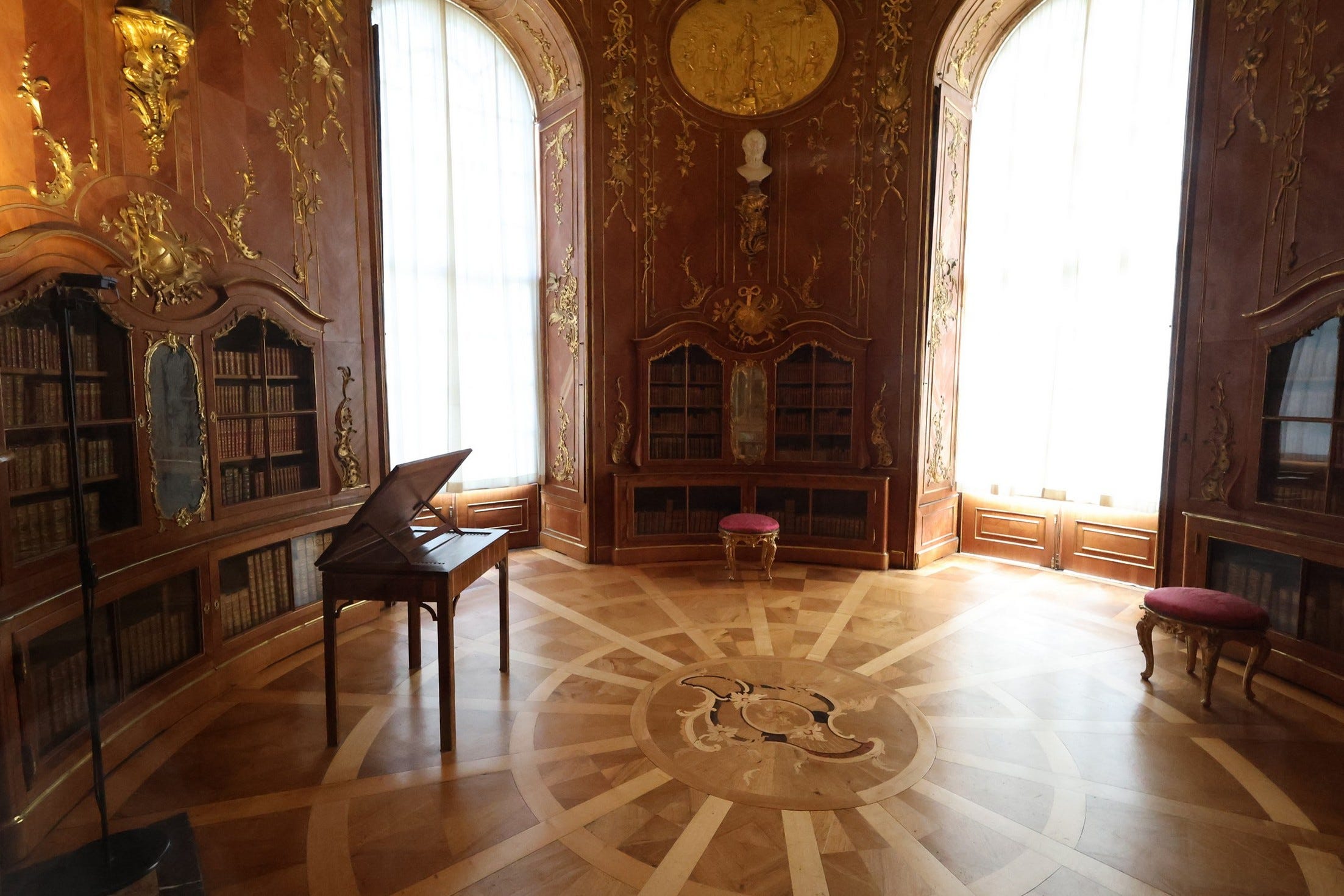
The next photo shows a statue, in another room, of Apollo, god of the sun, medicine, music, poetry, and the sciences, holding a copy of the Roman naturalist Lucretius’s De Rerum Natura, ‘of the nature of things.’

The statue bears a line from the work that reads, te sociam studio scribundis versibus esse, quos ego de rerum natura pangere conor. It comes from a passage near the beginning known as Lucretius’s invocation to Venus, the goddess who brings forth all things, penned in the hope that she will bring greenness to his own inspiration!
After begging Venus to send him a few ideas, Lucretius — who has a good claim to being the world’s first scientist — then went on to argue (somewhat paradoxically) that the material world is governed by natural laws that humans can figure out all by themselves, and that the old idea that the gods used to hurl thunderbolts, and so forth, were superstitions from what was, basically, humanity’s pre-scientific childhood.
The scholarly Frederick commissioned this statue of Apollo to honour the fact that De Rerum Natura was one of his favourites.
The next photo shows an elaborately decorated clock and the famous portrait of Frederick in which he fixes the viewer with a gimlet-eyed stare.
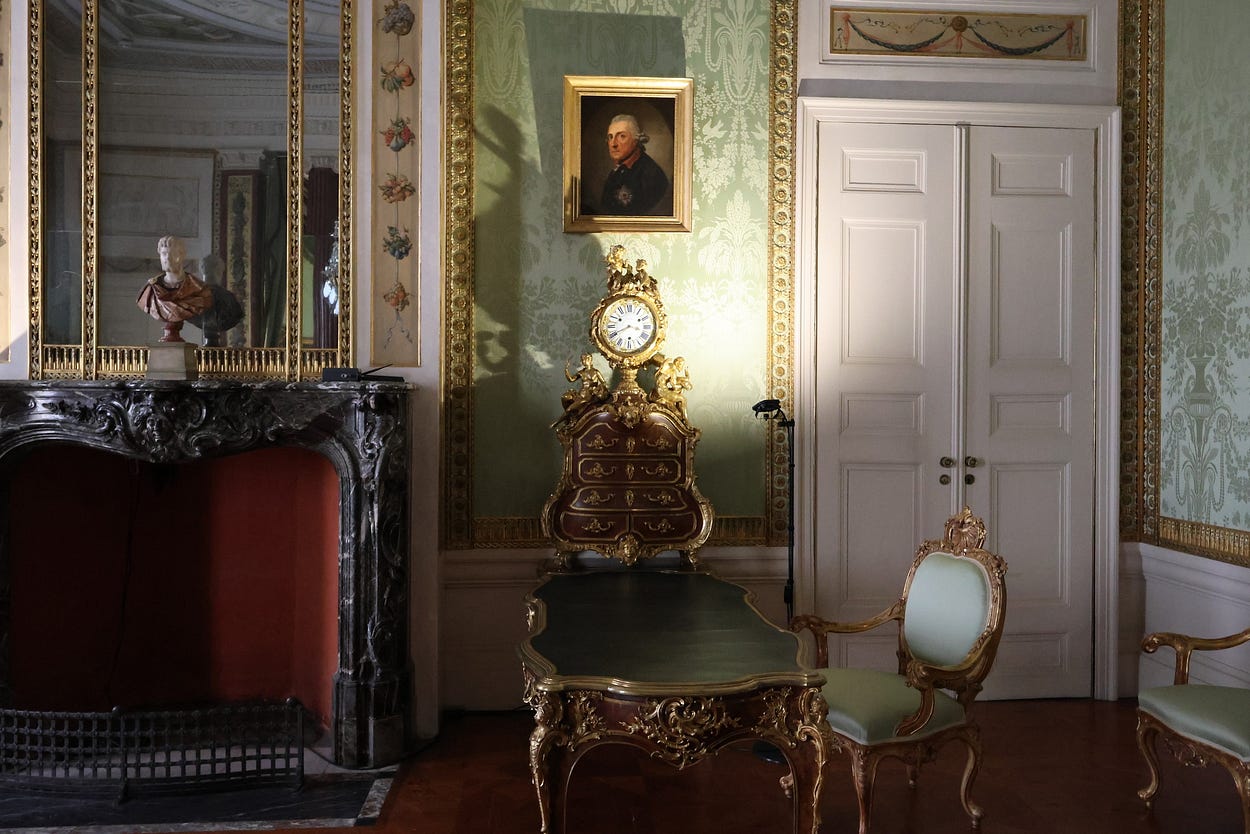
And here’s a closer view of the portrait.
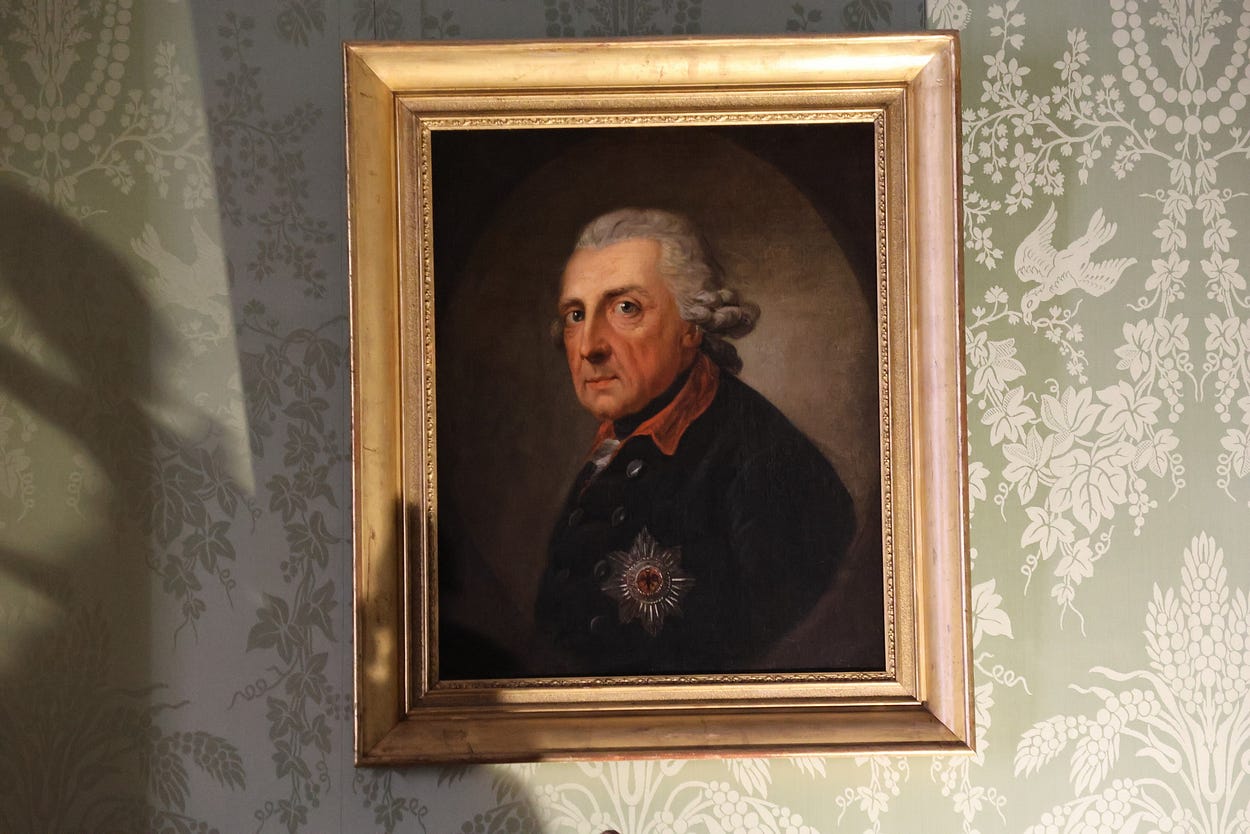
As I went back out, I saw paintings of eighteenth-century Potsdam, with some buildings I could recognise, notably the Garnisonkirche and the old town hall (St Nikolai was only built in the 1800s, even though it looks older). And a psychedelic Frederick:
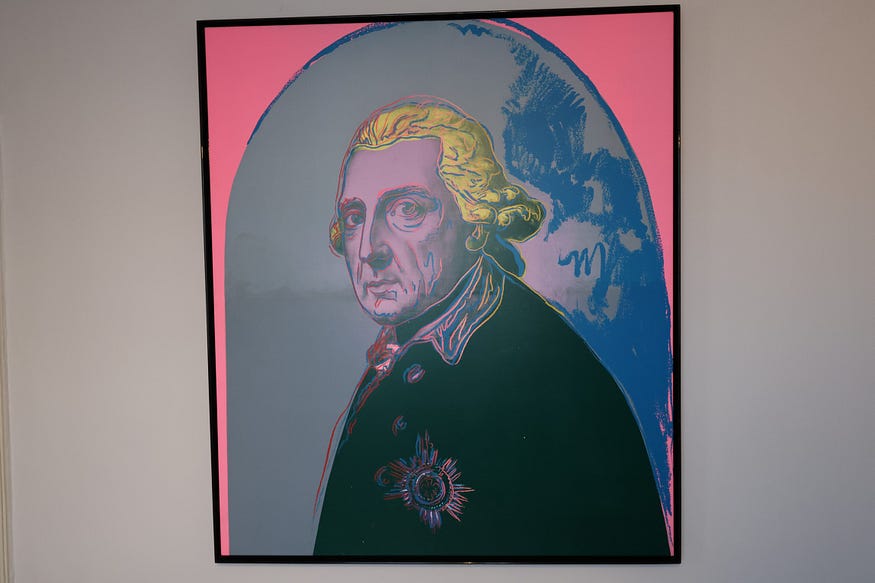
I bought a souvenir mug and some booklets. On reflection, I should have asked if psychedelic Frederick was for sale as well.
The back of the palace opened out onto a colonnaded courtyard and a lovely outdoor area.
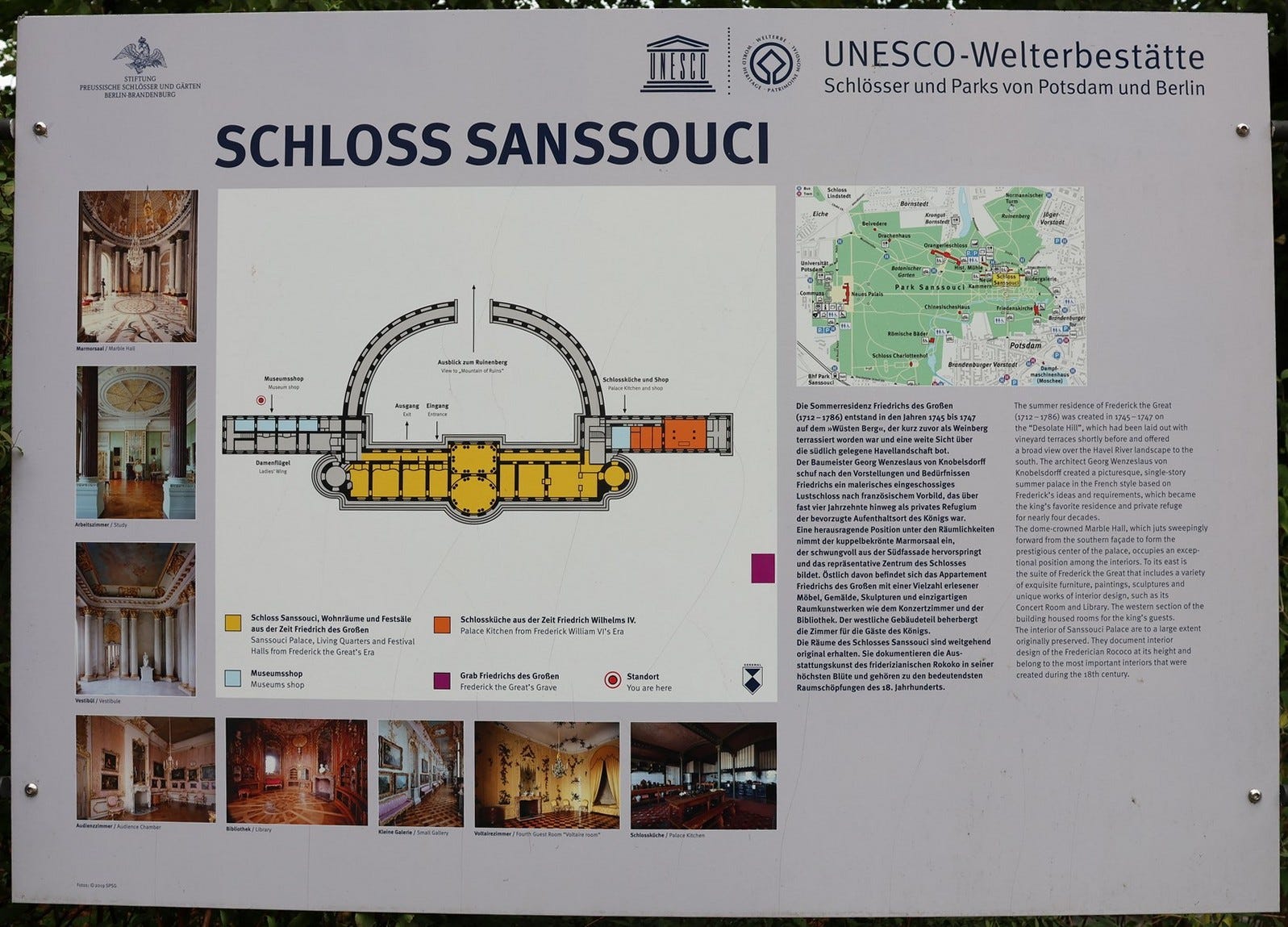
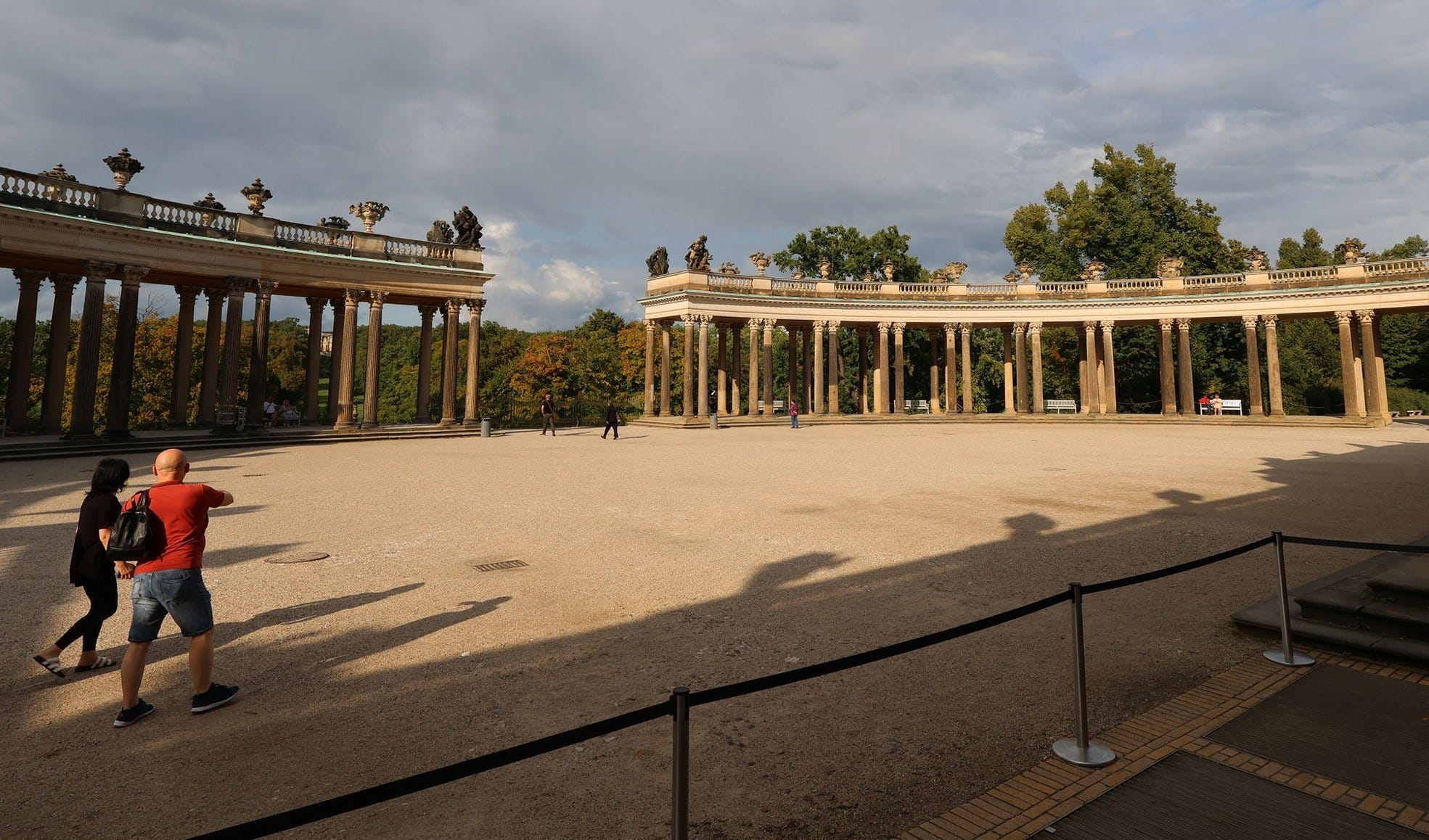
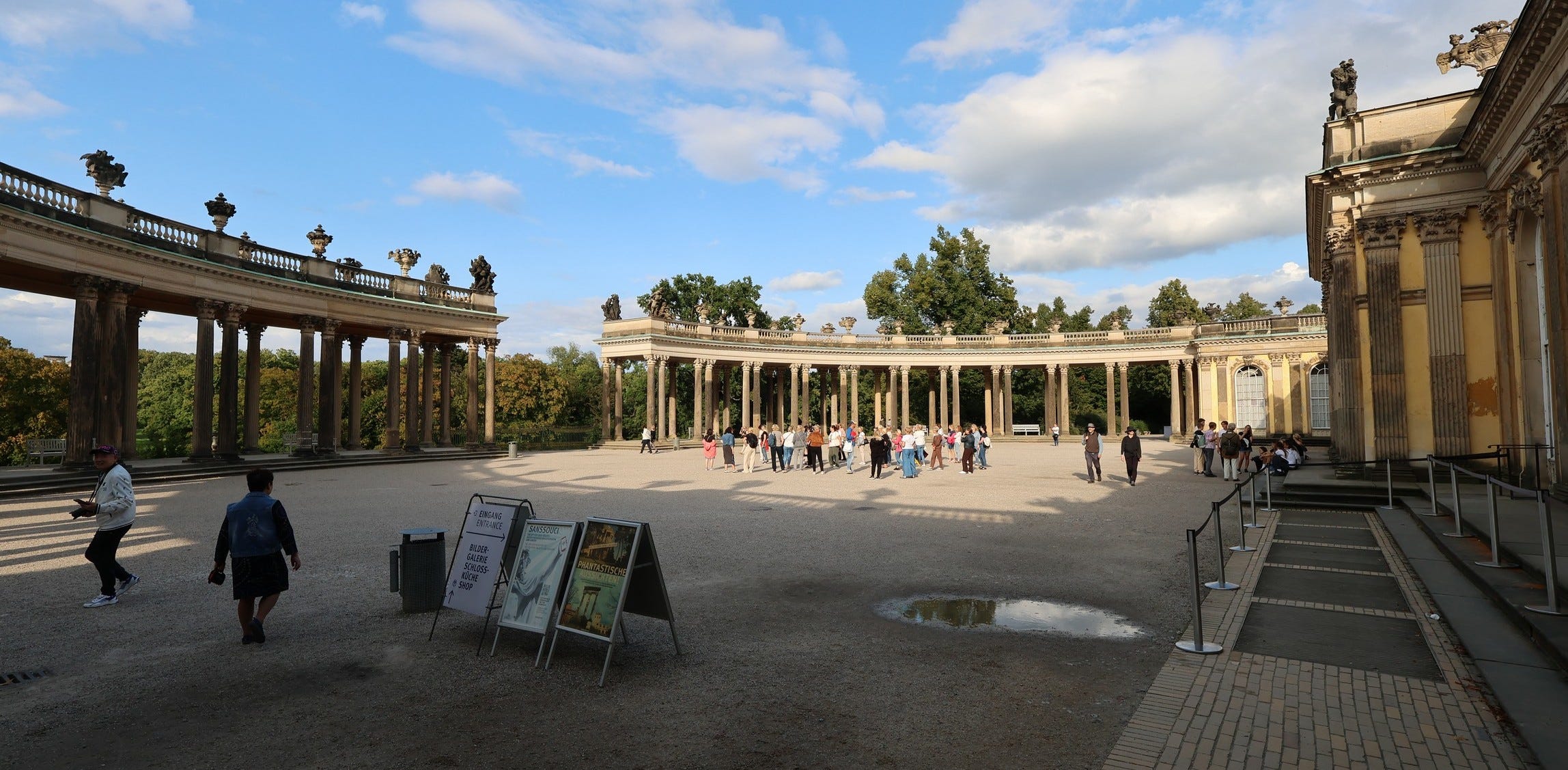
You can walk to the nearby picture gallery and a windmill that appears in one or two of the old paintings, under shade trees.

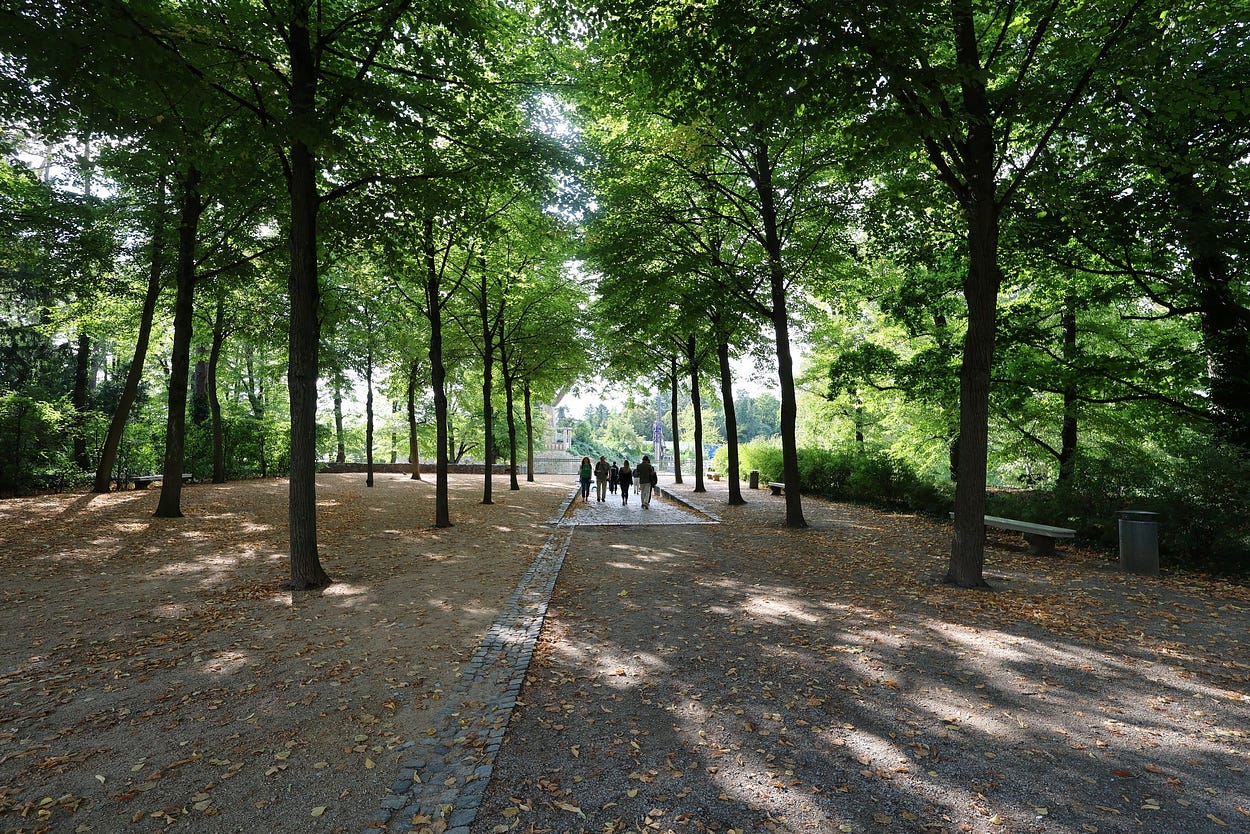
From the spot where the people are in the photo above, this is what you can see looking back to the Sanssouci Palace.
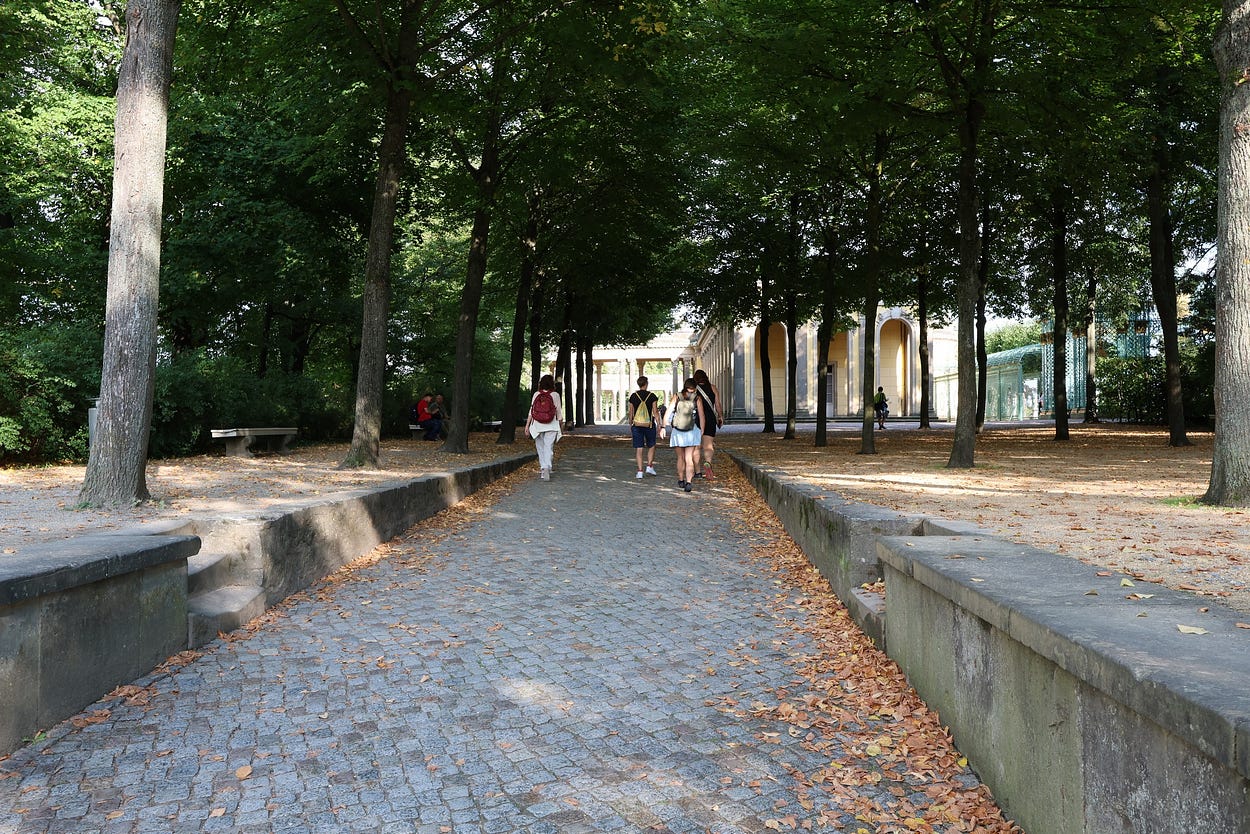
Here is a video of my visit to Sanssouci:
The palaces apart, there are plenty of other places you can walk to in this colossal park, such as the Drachenhaus, or ‘dragon house,’ a Chinese-style structure built between 1770 and 1772, now a restaurant and café with grand outdoor terraces.
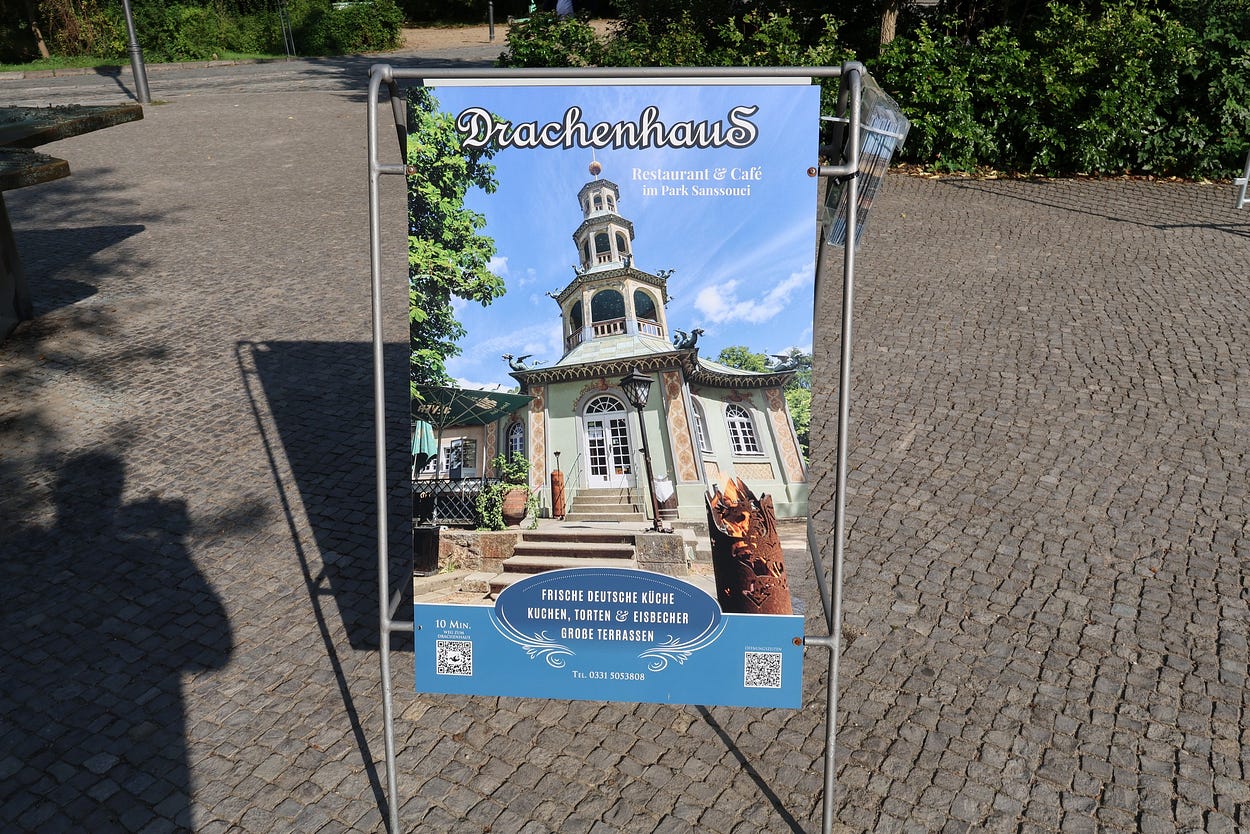
I went back down toward the fountain, noticing a hooded crow, endemic to these parts. I had only ever seen black crows before coming to Potsdam. The Germans call them Nebelkrähen, meaning ‘fog crows.’
After that, I walked westward along the lengthy east-west path in Sanssouci Park, toward the New Palace. Partway along, I caught a glimpse, down another avenue to my right, of another amazing palace, so I detoured in its direction. Here’s a video of what I saw:
This was the Orangery Palace, so-called because it has two long wings on either side with massive south-facing windows, inside of which, oranges were grown!
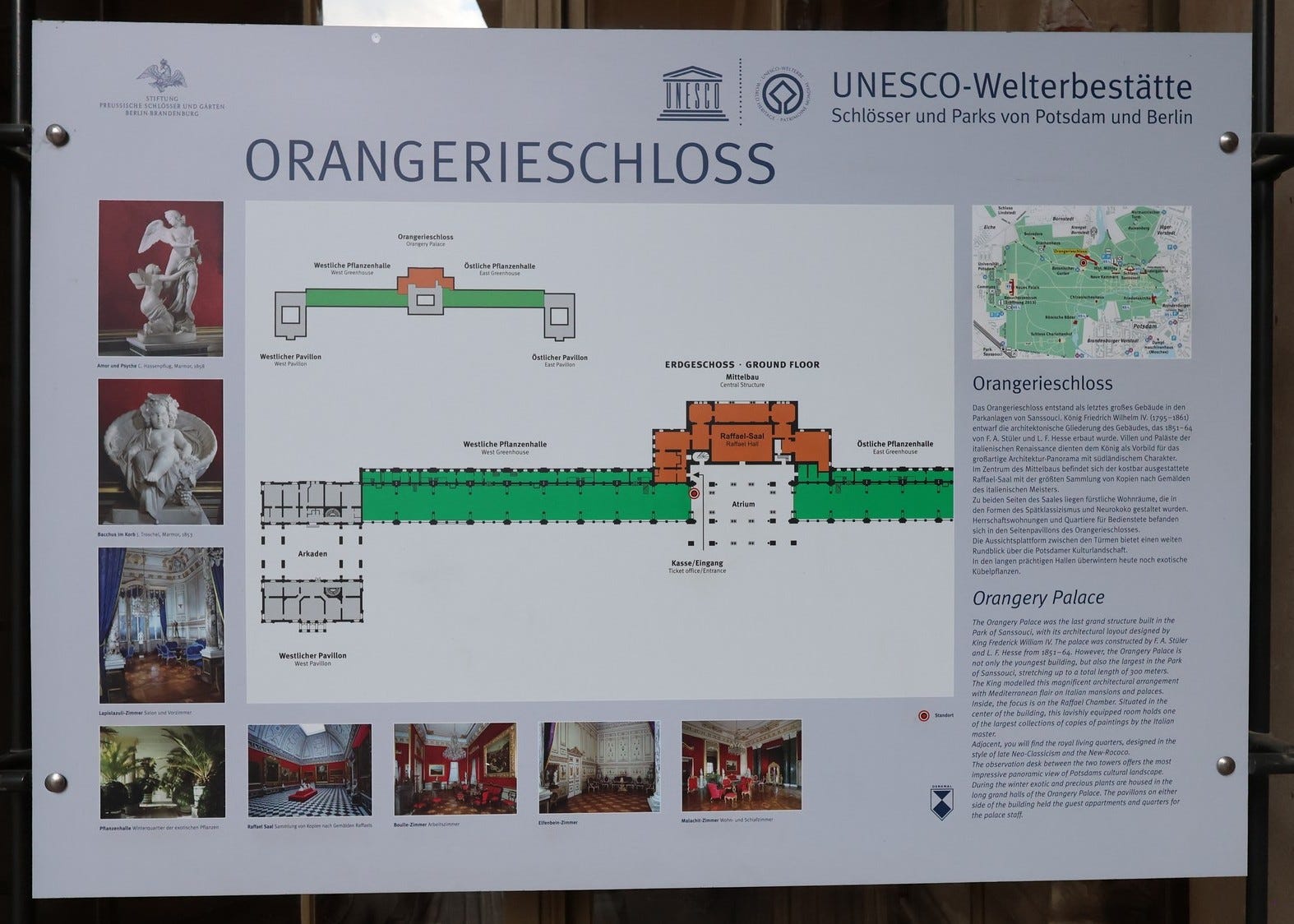
Before I climbed the steps up to the Orangery Palace, I walked through a section of park called the Neues Stück, or New Piece, past an equestrian statue of Frederick II and an impressive bronze statue called der Bogenschütze (‘the archer’), also known as Apollo der Bogenschütze.
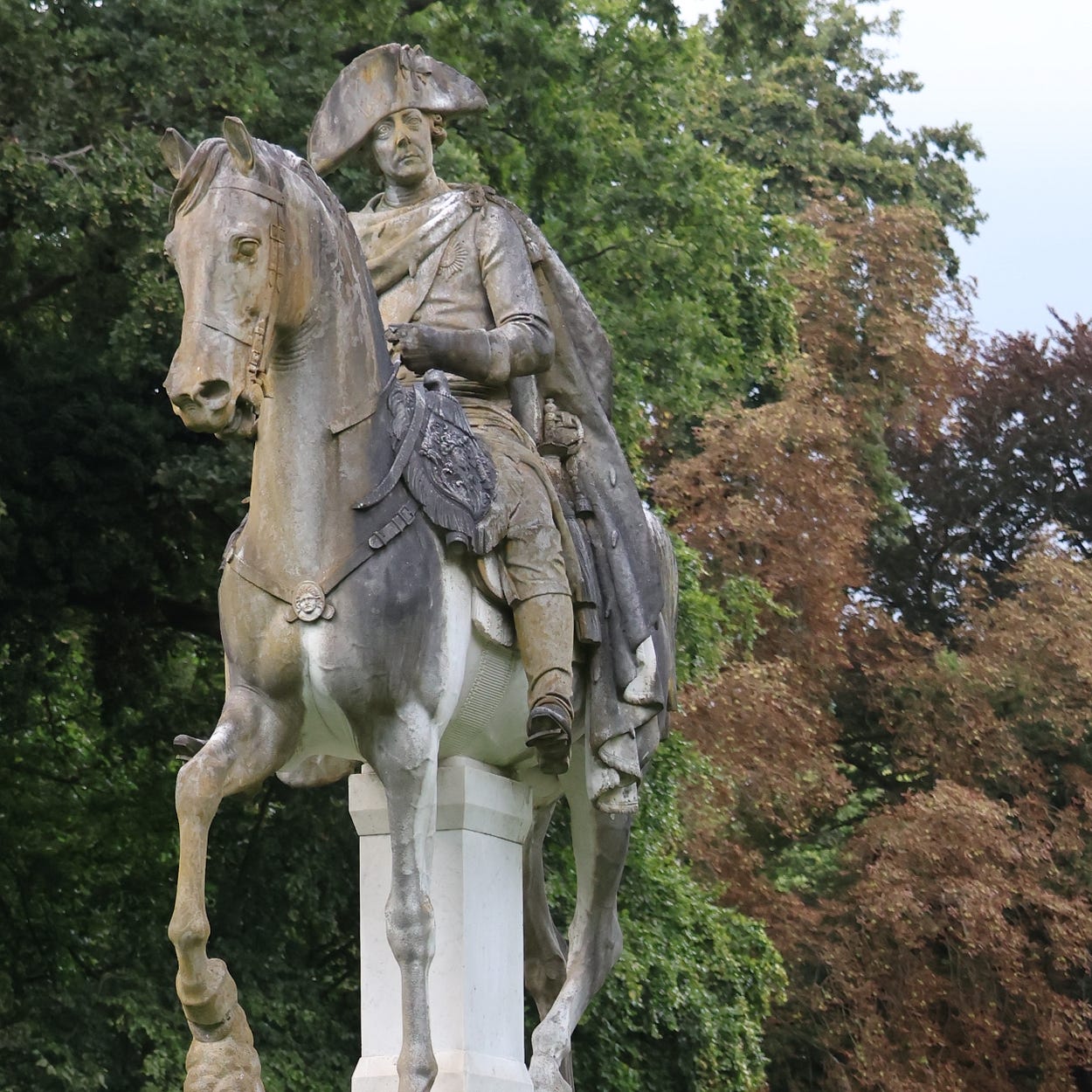
Completed in 1895 and cast in bronze in 1900, der Bogenschütze, which stands four metres tall from head to toe, is the most famous work of the sculptor Ernst Moritz Geyger.
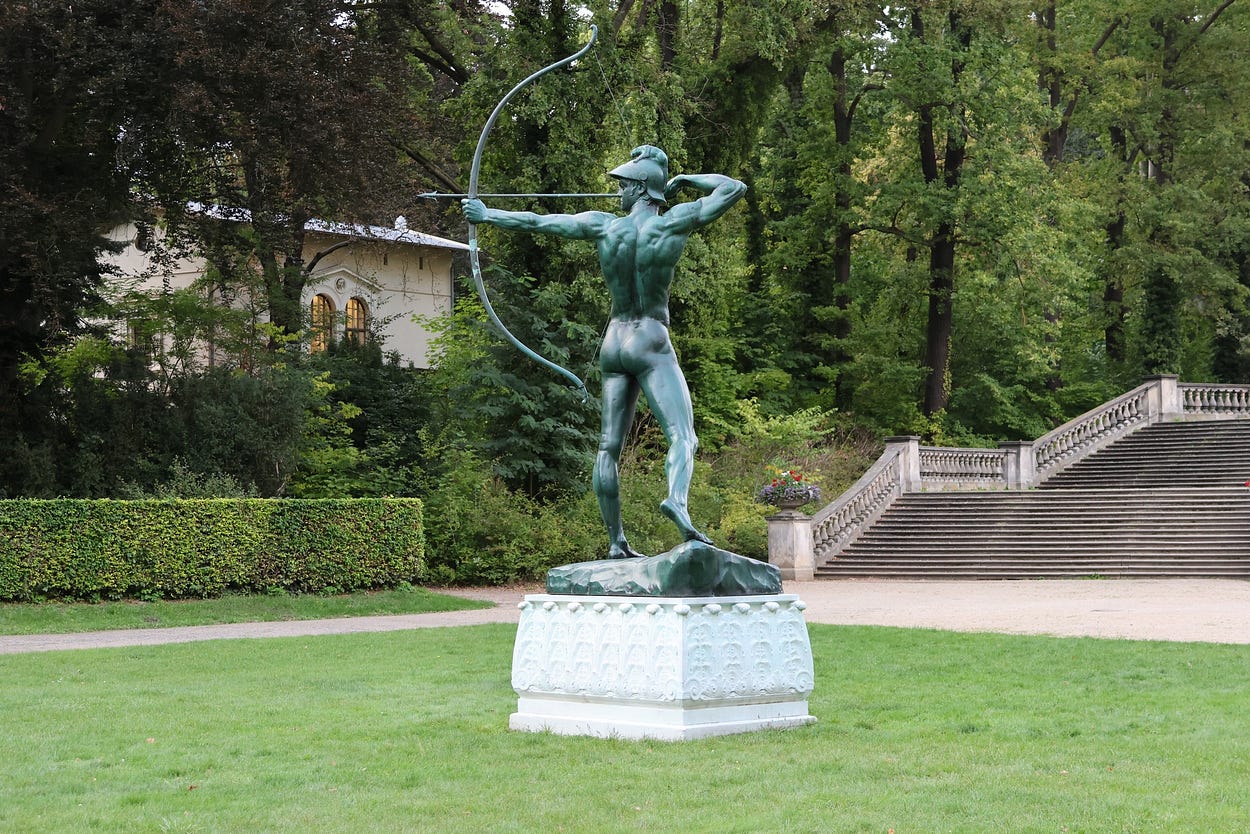
Kaiser Wilhelm II purchased der Bogenschütze for public installation. Smaller copies of it exist in several other cities, such as Dresden.
I’m not sure when der Bogenschütze arrived in the New Piece, but it might have gone in as a package deal with the steps, which are called the Jubilee Terrace, because they commemorate the silver jubilee of Wilhelm II’s accession to the throne in 1888.
The jubilee fell in 1913, one year before the outbreak of World War I. No doubt the Kaiser was looking forward to another 25 years on the throne and a golden jubilee, but it was not to be.
At the top of the two flights of steps there is a road named Maulbeerallee, or Mulberry Lane.
Beneath Maulbeerallee, between the two flights of the Kaiser’s steps, there is an artificial rock grotto that adds to the charm of this place, even if its patron had his flaws. You can see the grotto quite plainly in the video above.
Across Maulbeerallee, I had to climb some more steps, on which there was a pair of rearing stone cats. I thought that was rather impressive as well.
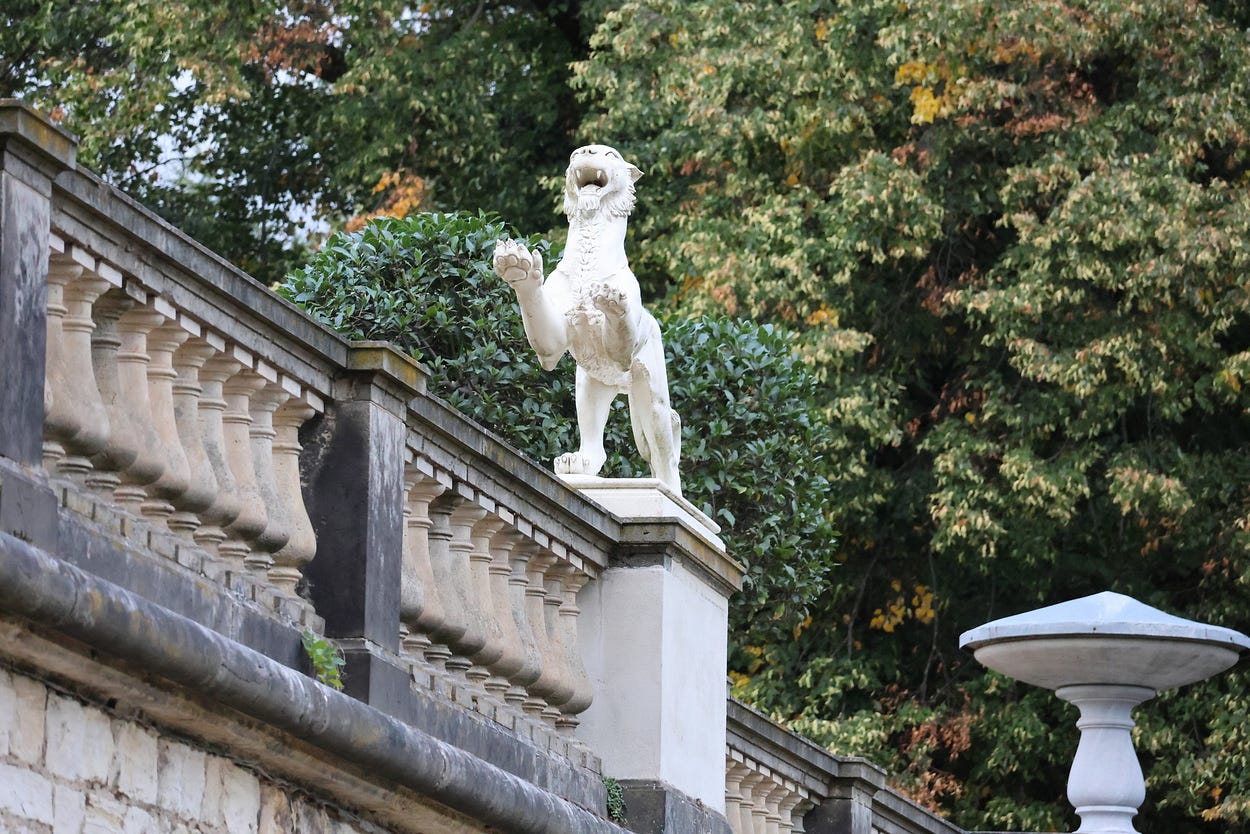
And so, I got to the palace, which, like the Peace Church, is in an Italian/Mediterranean style and faced by a bronze angel. Apparently, it is good luck to rub the angel’s bare left foot, though there might be a Parkordnung rule against doing so lest thousands wear it away.
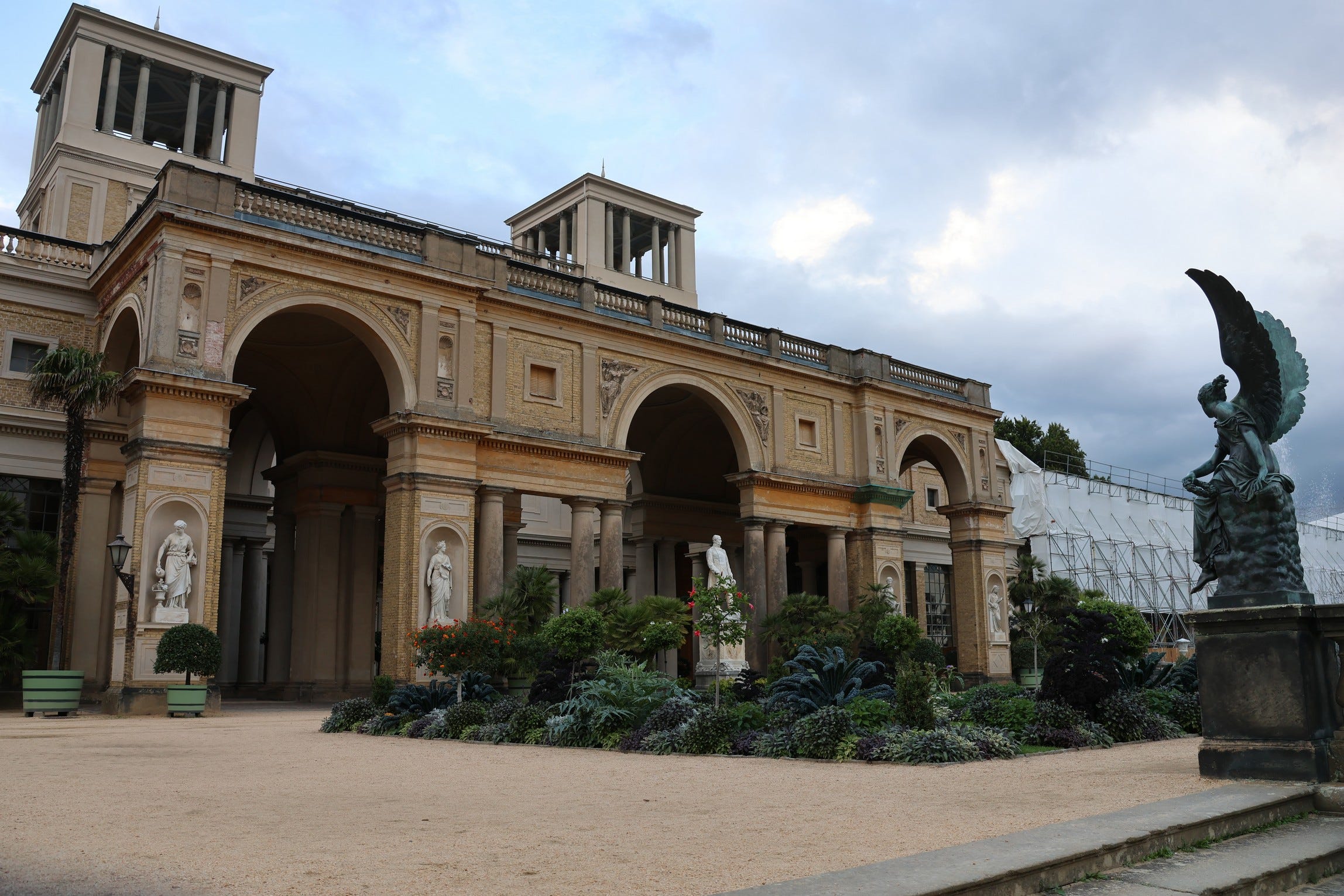
Italian-style seems to have been the favourite of Frederick William IV, the reigning monarch at the time it was built.

At the Orangery Palace, I saw small shrubs and trees of the warm-weather kind in pots, which would be taken inside at the first sign of frost.
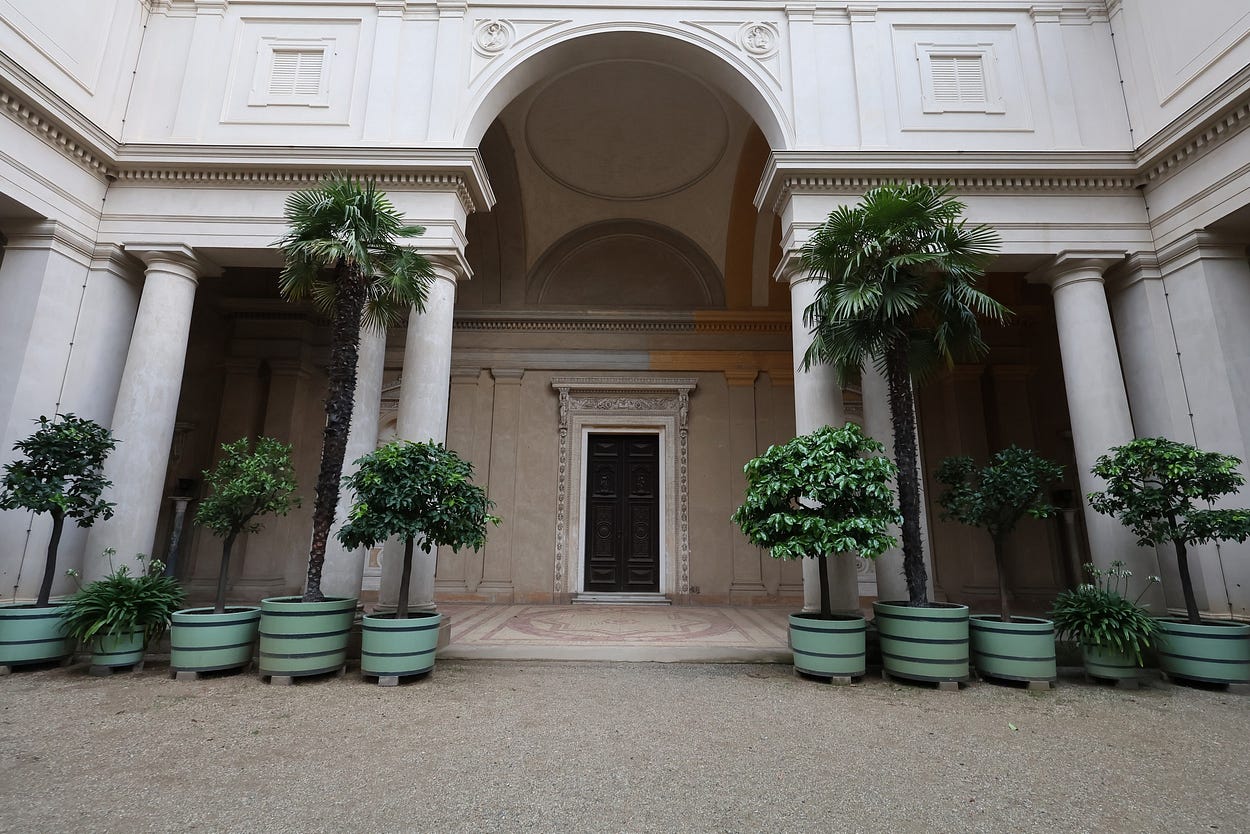
I managed to get a photograph of the interior of one of the orangery wings, with its huge south-facing windows. In the past, that is where the shrubs would probably have been taken to create a winter garden among the orange trees. Orange blossoms would have scented the whole place wonderfully.
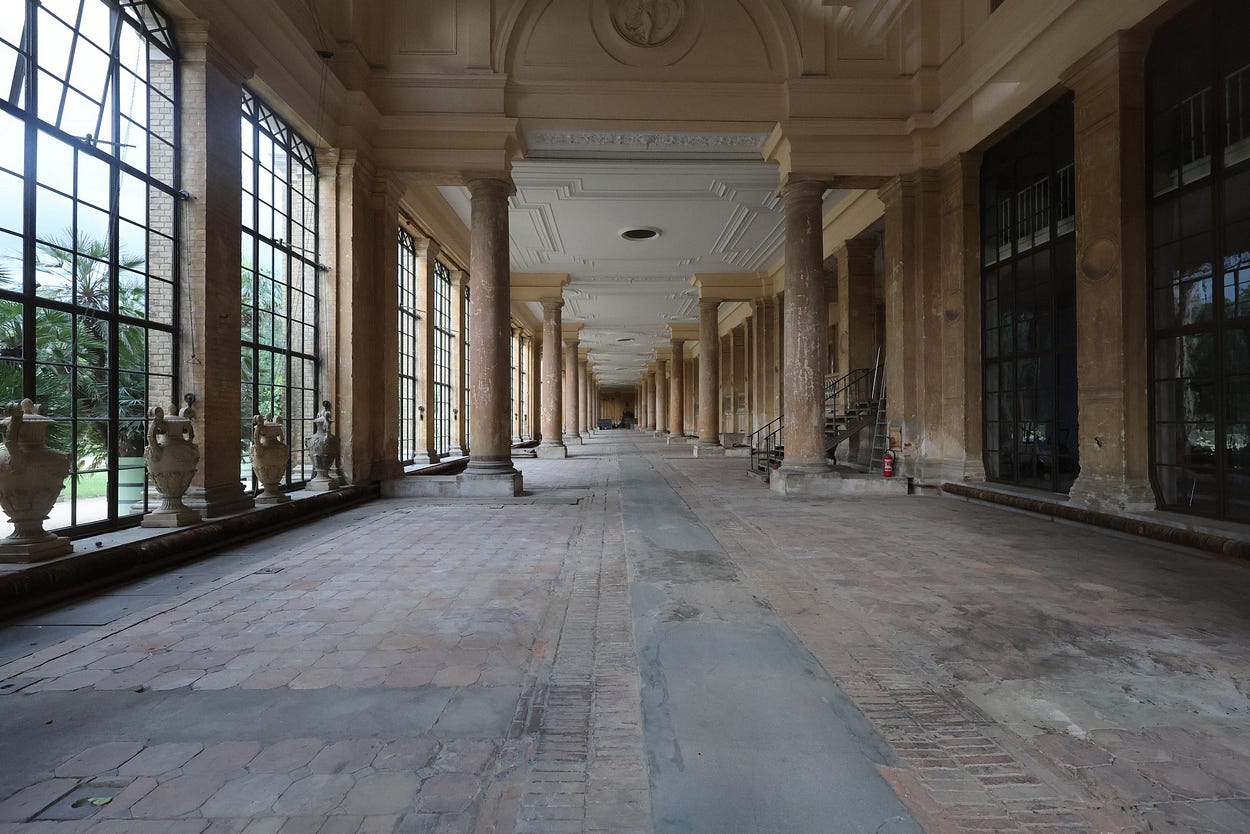
I hiked back down the steps, past the fountain and the archer and Frederick II on his horse (‘Old Fritz,’ as he is known), to the east-west path, and continued toward the New Palace.
Unfortunately, just then, a thunderstorm erupted with drenching rain.
I thought there would be some kind of shelter at the New Palace, but everything was cordoned off for works, so I had to keep going in the rain, clutching a tightly folded bag with my precious Canon camera and its two zoom lenses inside, and hoping I didn’t get struck by lightning.
In search of somewhere that might have had a sheltering roof, I ended up leaving the park only to find myself still in the open, hiking through a great field of allotments: places where people, who otherwise live in blocks of flats, have gardens and tiny cottages. This is something you see in Britain as well. Narrow Gartenwege, ‘garden ways,’ ran between the allotments.
I took a photo of the entrance to one of the Gartenwege with my cellphone, as I wasn’t going to risk the fancy camera in such weather. I think it had stopped raining for a minute or so when I snapped this one.
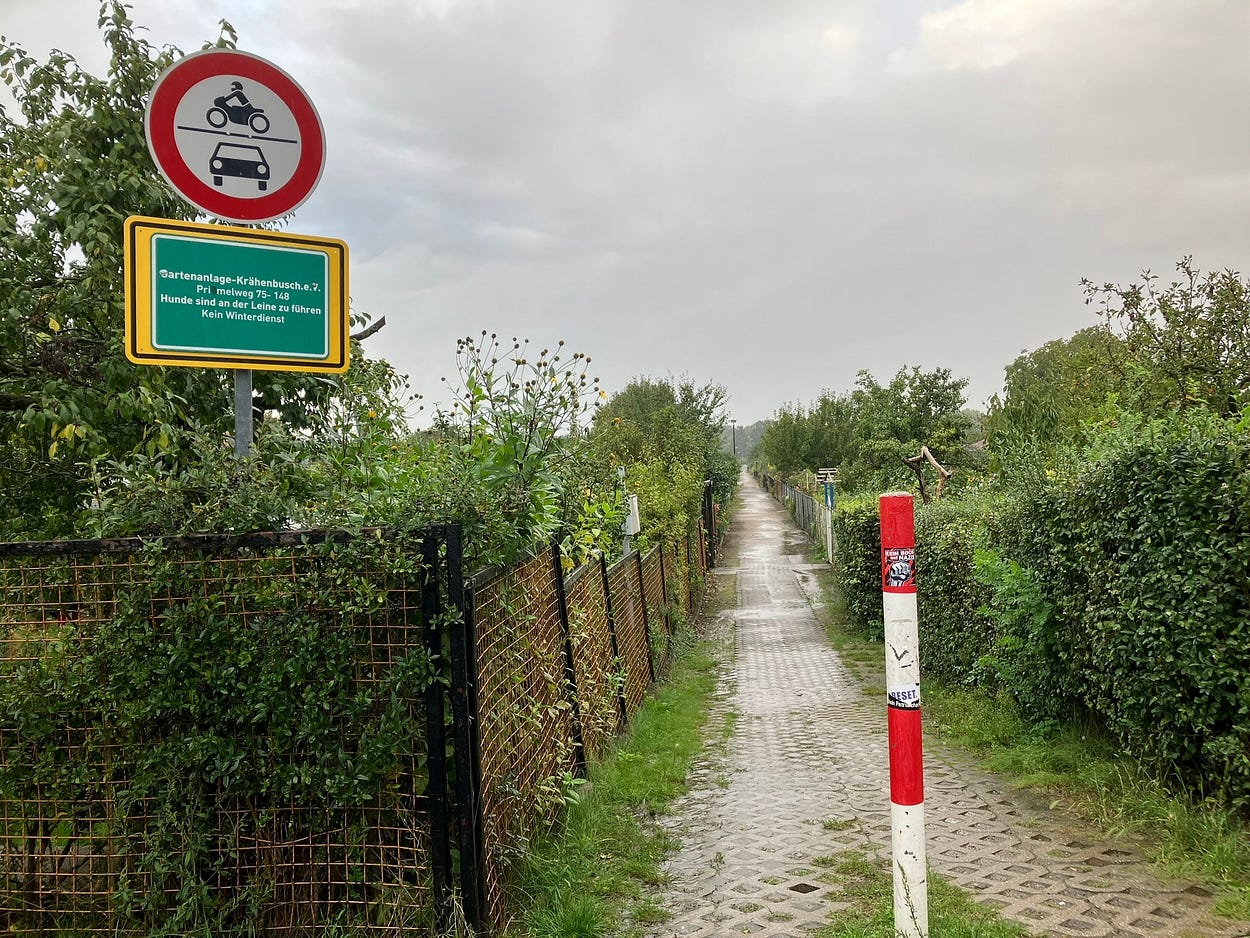
Still, if it hadn’t been for the storm, I wouldn’t have discovered this interesting side of local life.
Eventually, I made it to a tram stop on Zeppelinstrasse called Luftschiffhafen (‘airship haven’). This was just two stops from where I was staying, at the Yachthafen (Glamping-Ei) on Kastanienallee.

Back in the days when the Germans built airships, of which the most famous ones were called Zeppelins, whence the name of Zeppelinstrasse, this was an important site of their manufacture.
The old turn-of-the-twentieth-century gates of the former Luftschiffhafen were still there, though the actual airship field has long since been converted to other uses.

There is so much more to see in Potsdam, the town of 17 palaces, and all this really only scratches the surface. For instance, I should have taken a hike up Potsdam’s Telegrafenberg (Telegraph Hill) to see the Einstein Tower, perhaps the most over-the-top example of 1920s German architecture, but I forgot to do so.
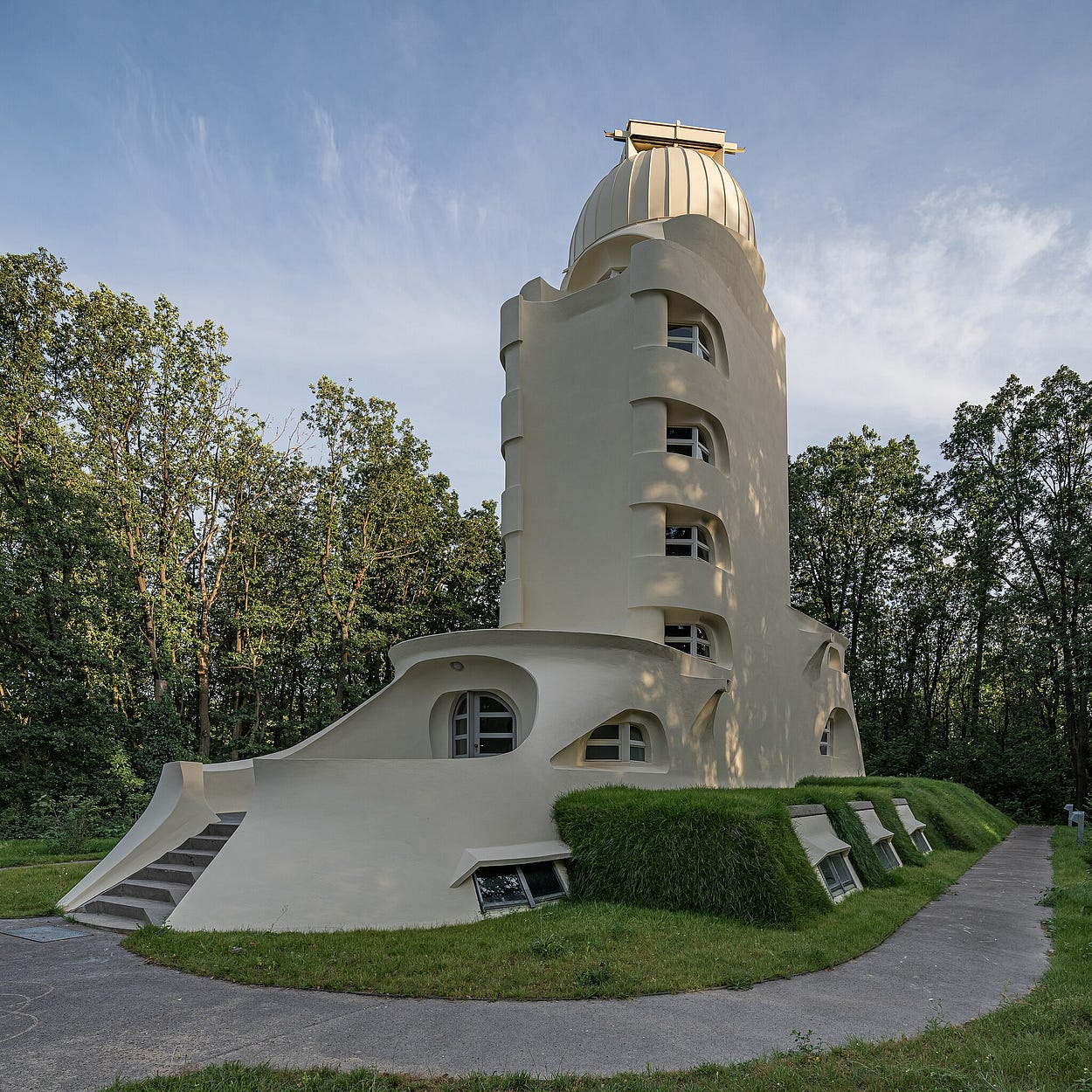
The Glienicke Bridge, the ‘bridge of spies’ that you see in so many Cold War dramas, which has Potsdam at one end and the former West Berlin at the other. Spies arrested by one side would be swapped for spies arrested by their adversary. The swop would take place in the middle of the bridge on a really dark and rainy night, everything illuminated by car headlights reflected in the puddles and with all the guards at each end nervously fingering their weapons — or so it went in the movies, at any rate.

And the Cecilienhof Palace, which is more like a manor house and not as spectacular as some of the other palaces, but which is famous because it is where the July 1945 Potsdam Conference between the newly-elected UK Prime Minister Clement Atlee, the Soviet ruler Joseph Stalin, and US President Harry S. Truman (who had become president after the death of Franklin D. Roosevelt in April), to determine the future of Germany and other matters, was held. There is a permanent museum display about the conference at Cecilienhof.
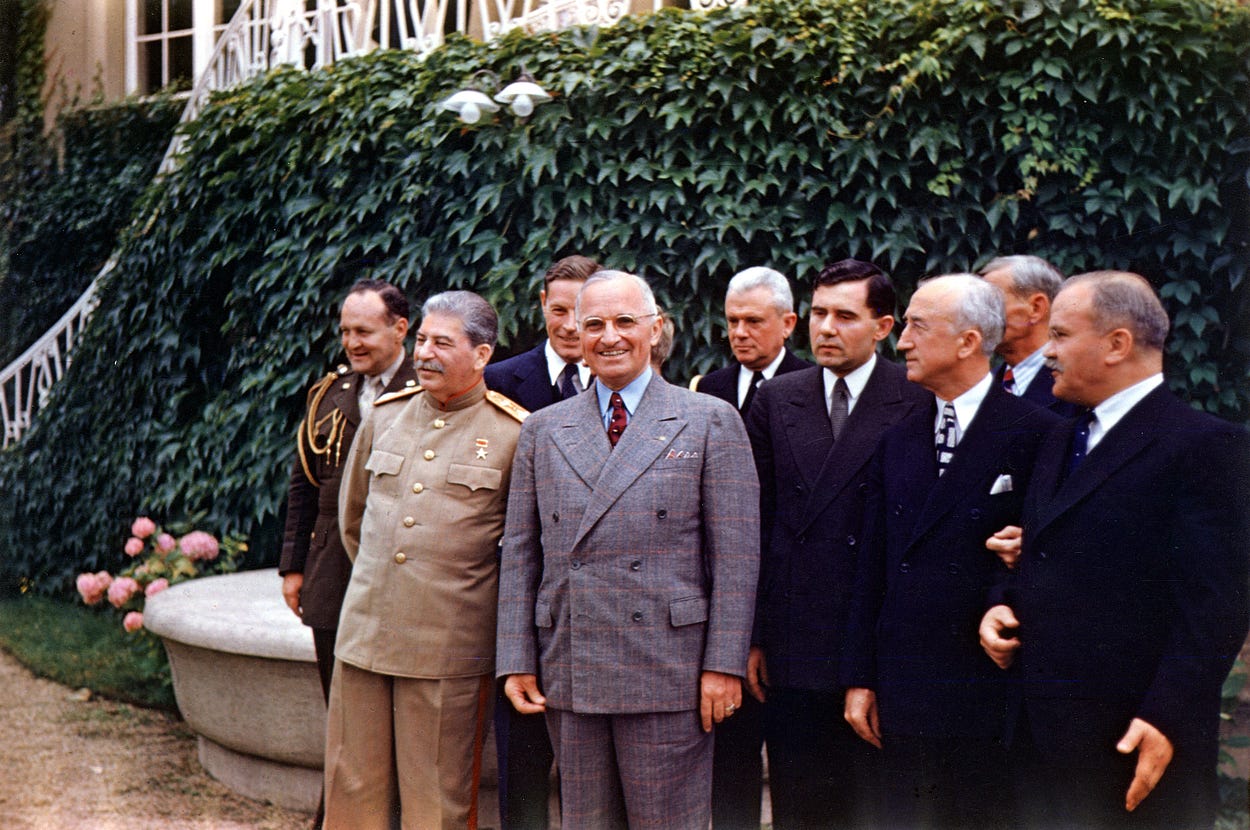
Searching on the Internet, I found some old colour films of what Potsdam used to be like. The following one records a lot of the destruction, some scenes from the conference (or at any rate, officers who had tickets to get in), lots of Soviet troops, and the famously sharp Soviet female traffic-directors, who made waving their flags into something of an art form.
Anyone who has read the last three posts on this website might recognise some of the landmarks in that film, and again in this one, made in the dying days of East Germany, in 1990.
The next film is also very interesting. While the glories of Potsdam, which the film calls ‘Germany’s Versailles,’ were not totally neglected by the Communists, they didn’t do much to try and turn Potsdam, or anywhere else in East Germany for that matter, into a destination for Western tourists.
For that reason, and as I mentioned in the last two posts, much of what we now see in the inner city of Potsdam, such as in the Alter Markt, the Luisenplatz, and, of course, at the Garnisonkirche, is actually the product of restoration efforts that only began in earnest after German reunification in 1990.
The push to restore the inner city began as a grassroots community initiative. The Potsdamers made small restorations at first and then, once the idea caught on, bigger ones followed.
Finally, to round off, I made it back to Glamping-Ei at the Yachthafen, and watched the sun go down, reflecting warmly off brick towers on the other side of the waterway.
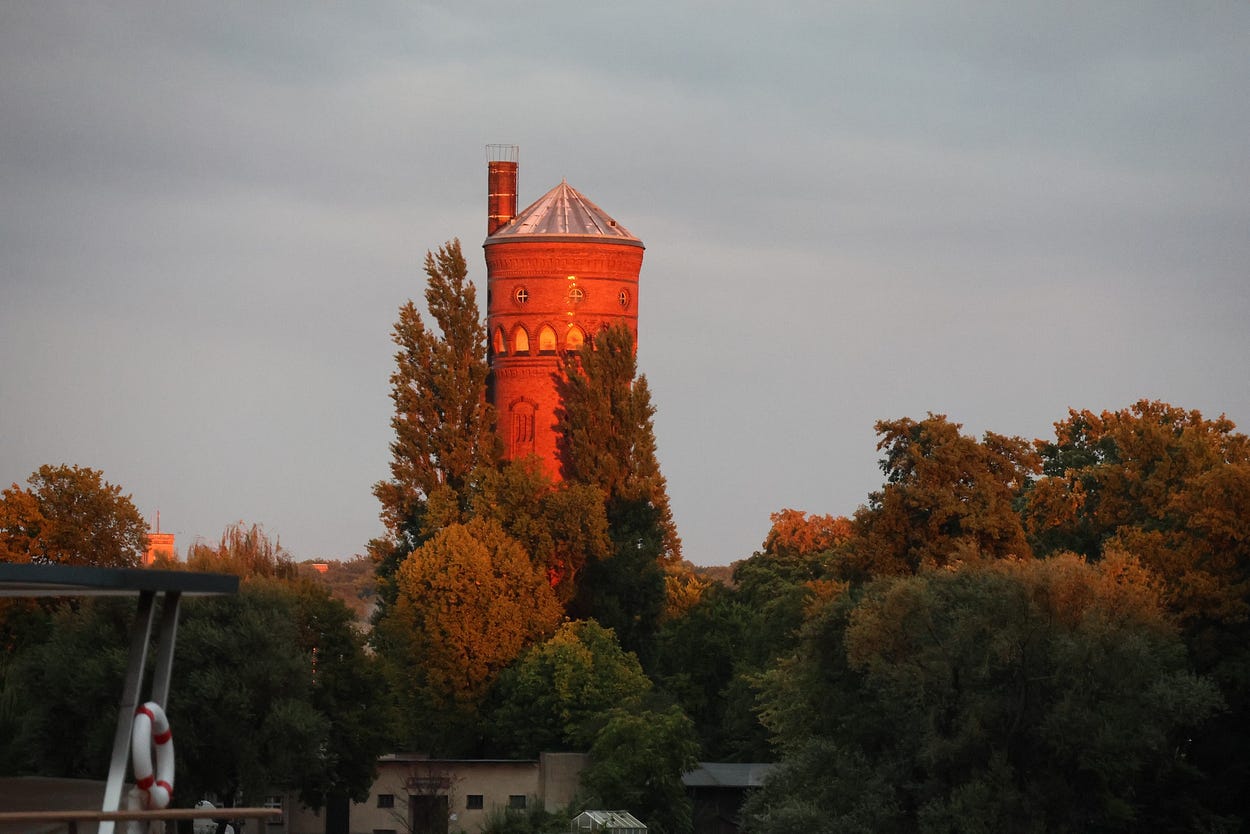

The last photo, also taken at the Yachthafen, was actually photographed at dawn, but you can pretend it is a sunset photo!

Next week, I head for Berlin.
Subscribe to our mailing list to receive free giveaways!